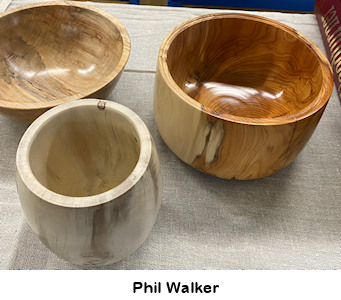
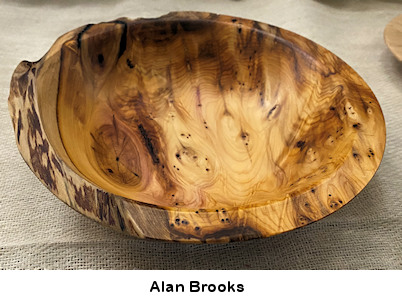
(click for close up view)
April 2025 -
Appraisal Table
with Andy Ogilvie
Phil had brought in a spectacular looking steep sided Yew bowl,
highly micro-crystalline waxed with a split level rim. Also a Holly hollow form
from a tree he had cut down about a year ago and turned recently.
Alan's Yew bowl had been treated to Hampshire Sheen's Citrus Burnishing Oil
leaving a food-safe satin finish.
With Easter fast approaching, Merls has been turning eggs from exotic off-cuts -
a colourful selection of Lacewood, Walnut, Box & Judas Wood. Andy's tip for an
ideal egg shape was a semi-circle attached to a parabola, but he did teach
Mathematics in his past so what would you expect!
Allan's wet-look bowl rim is achieved by painting a mid-blue water-proof base
colour first and once dried, introduced some water droplets out of a spray
bottle before a dark blue aerosol was directed horizontally across from one
direction and then a pale blue aerosol from the opposite side. After the water
had evaporated away, the fine coats settled onto the base coat as highlighted
below and were stabilized with a coat of lacquer before the bowl was hollowed
out with an undercut to preserve a wide rim to show off the effect.
(click for close up view)
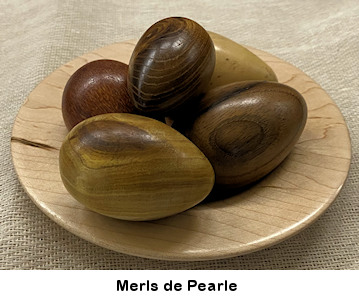
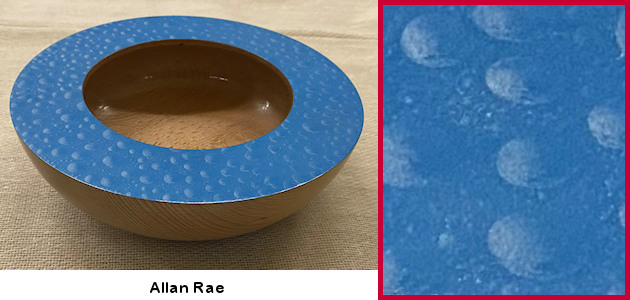
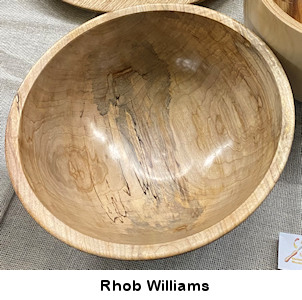
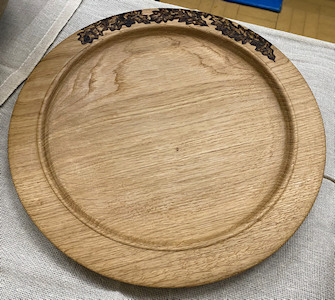
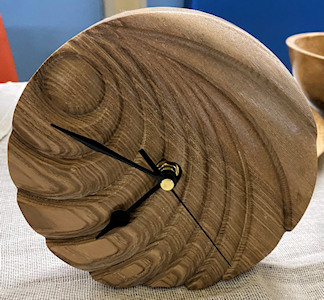
(click for close up view)
It has been another full month's work from Rhob's workshop.
A Japanese Maple bowl; an Oak platter with some intricate leaf design on its rim
(clearer view if photo clicked) created with a diagonal shape from his Peter
Childs Pyrography kit. - the technique was to drag the iron back after the first
contact had burnt black; a Sauracker Shell shape
that he had shown us in February 2024 had now been re-modelled as a timepiece -
Rhob commented that although some might prefer the small circle at 12 o'clock,
the piece already had a flattened foot from its original incarnation;
Below is a Walnut bowl; a Catalpa (aka Indian Bean Tree) bowl with its fluted
sides incorporating this wood's typically stable pith; a couple of threaded
acorn boxes with their cups acting as stands; another box formed from a Chestnut
Gall; a couple of pens from a stunning piece of Thuya Burr and finally a
child's birthday present in the form of a colourful bird from off-cuts.
(click for close up view)
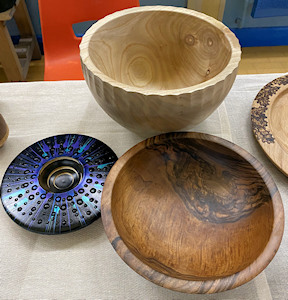
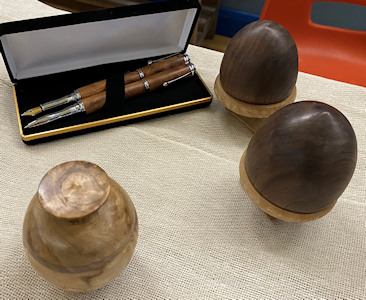
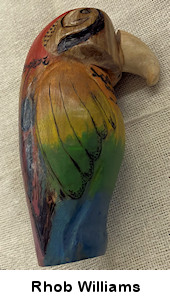
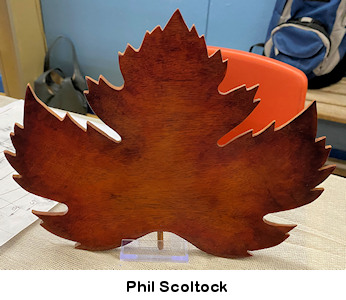
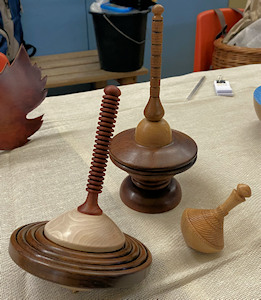
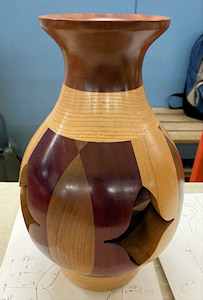
(click for close up view)
Following a recent trip to Canada, Phil created a Maple Leaf, paradoxically out of Brazilian Tigerwood, more commonly used for Flooring & outdoor furniture; spinning tops made with dense close grain wood to create the weightiness and low centre of gravity aided with metal tips which Phil told us could sustain typically 4 minutes before toppling; as a nod to tonight's Inside Out demonstration, he has brought 3 large examples together with a technical drawing he had used to calculate the appropriate dimensions as he didn't have access to modern day CAD software that Rob Randall had used.
Having spotted the renown Four T's puzzle on line, Andy decided this would be a satisfying turning project, although he did ask a friend to laser cut the Perspex for the necessary accurate dimensions of the T's. The base for the 100mm circular play area was of spalted Beech burr after an earlier attempt with Hornbeam had suffered so much shrinkage that he had to remount on some Cole Jaws and remove another half a millimetre from the rim for the Perspex to still have room to fit flat to the base; at the recent Yandles Day Event, professional Jason Breach was showing examples of Streptohedrons, which Andy had previously demonstrated to the Club (Feb 2023) - however, these were boxes, which were a far more difficult project than creating the shapes in the first place; Andy's first attempt at a segmented bowl had 15ș segments (as shown in the close-up view) which he thought would require 24 such pieces (15 x 24=360) but instead required 21 pieces. Although the width of a dark & pale segment is slightly smaller at the bottom due to the wedge shape, it extends more than 17ș on the circumference of the smaller circle at the base, hence only room for less segments; and finally was Andy's champion Spinning Top which hasn't toppled over after several months since set spinning - primarily due to the design which stops it from touching the ground!
Awards
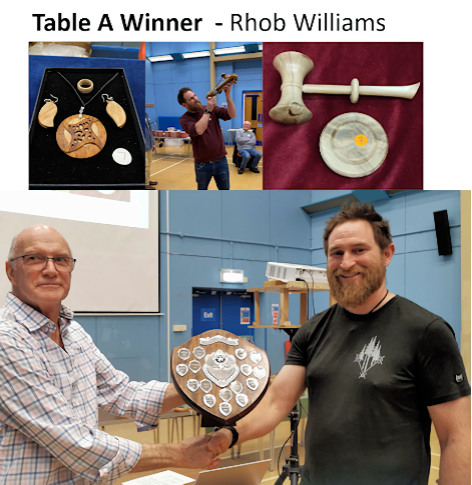
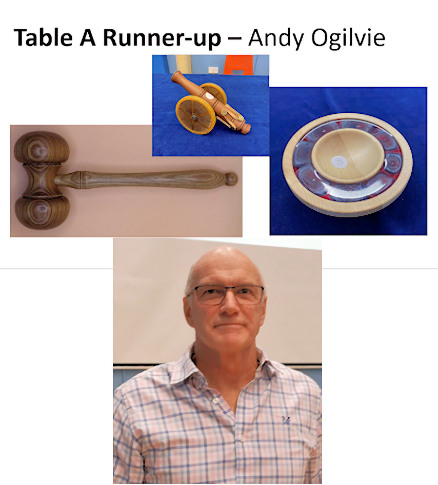
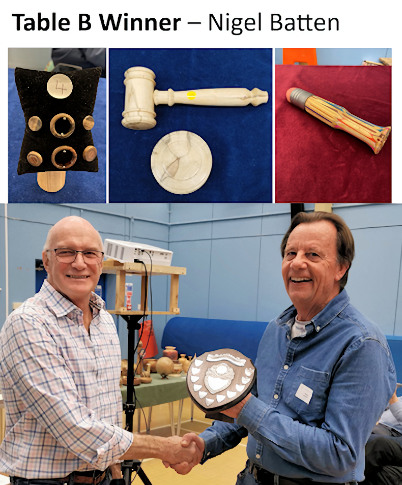
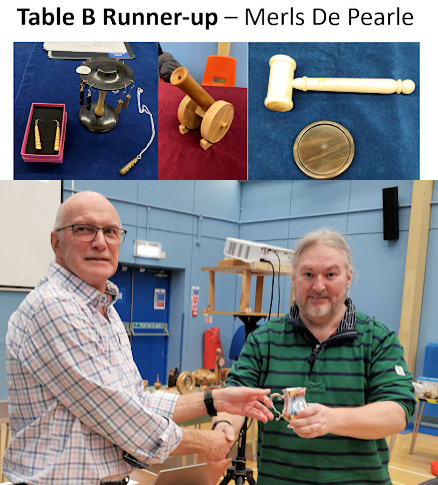
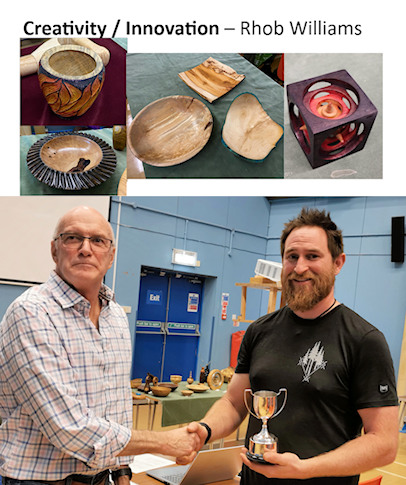
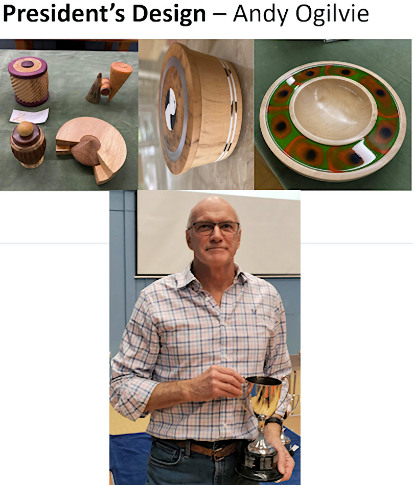
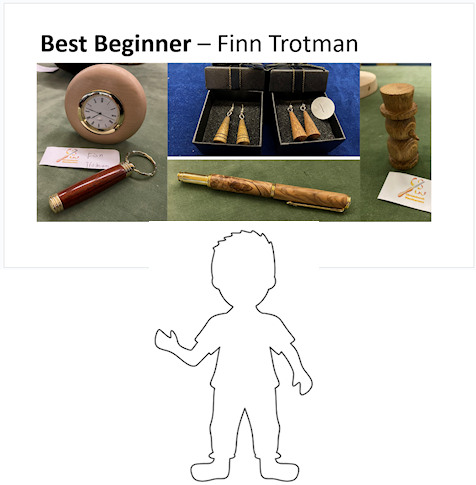
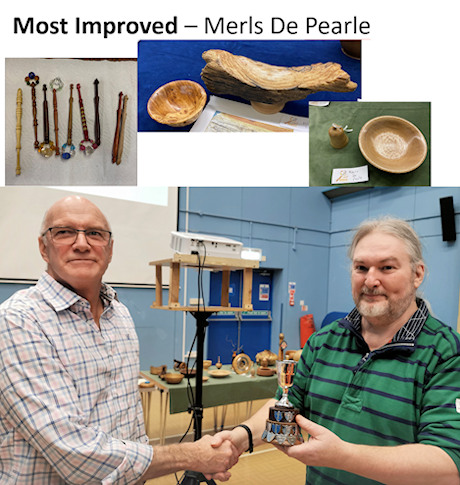
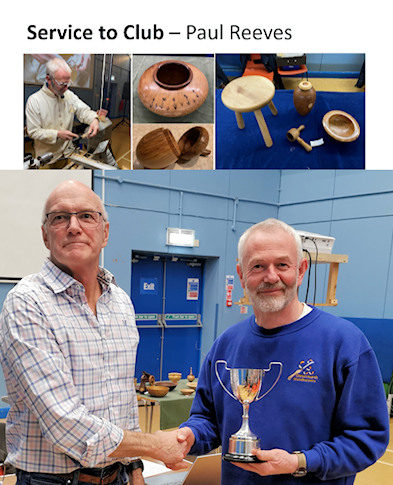
March 2025 -
Appraisal Table
with Paul Reeves
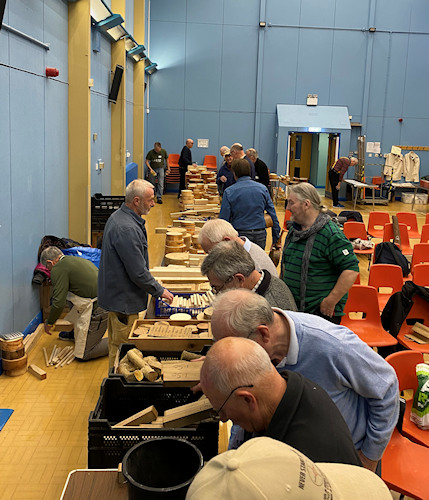
To accompany the 'End of Term' theme of the AGM & Wood Sale, the Chairman
had asked Members to bring along examples of their first bowl/platter/hollow
form they had turned. Paul speculated that perhaps some on the table were
Member's later attempts as they didn't feature the regular rookie perils that he
focussed on first.
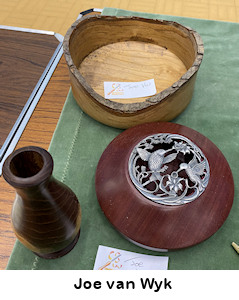
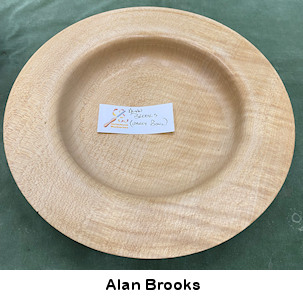
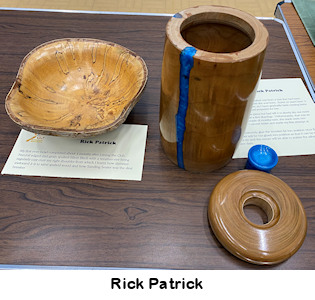
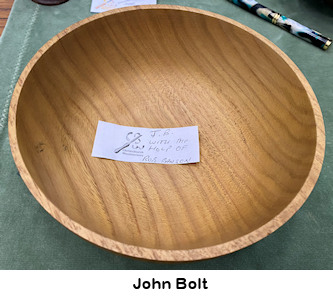
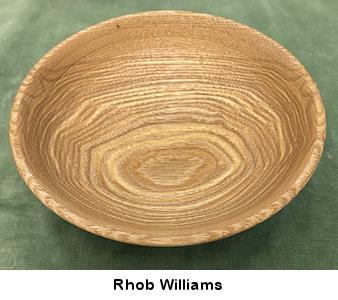
(click above for close up view)
◙John's thin walled first bowl had a fine finish which he wished
he could consistently achieve today, decades later.
◙Rhob considers his first bowl's foot as too big & thick, which he could easily
remount and correct, but then it would no longer be his first bowl.
◙Andy's bowl was turned while attending a past Member's (Andy Browne) "Experience
Day" course.
◙Trevor and his Cabinet Maker's background is conspicuous in this spalted Beech
bowl with its well proportioned shape from detailed lip through a wide curved
side to a narrow neck then back out to a good sized foot.
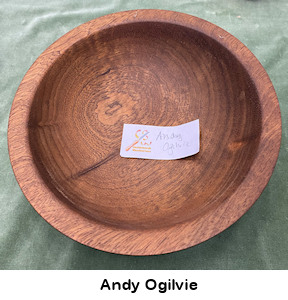
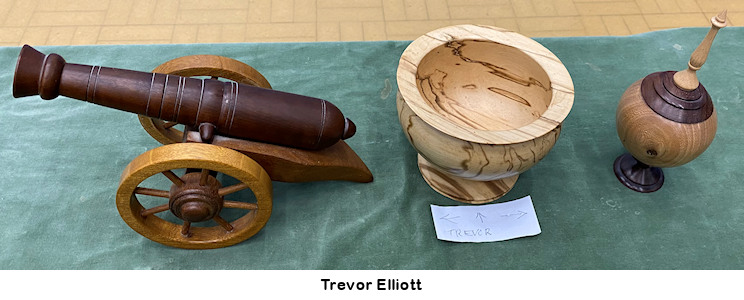
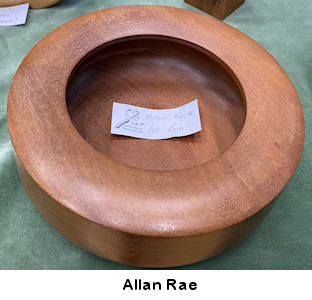
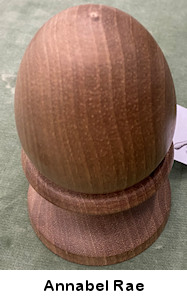
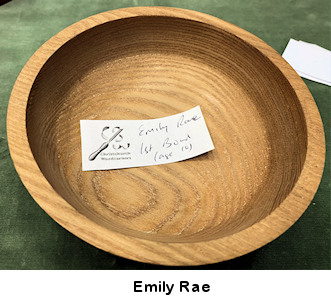
(click above for close up view)
◙Allan's first bowl is another "very early on" example with its
large undercut bowl rim which is so difficult to execute well even after years
of practice and the choice of using 'window wood' adds to the hassle. Allan's
Daughters,
◙Annabel &
◙Emily, had persuaded their Dad to take along their first
ever pieces which revealed that avoiding complicated first attempts invariably
draws out encouragement like, "Nicely done!"
Paul recounted that years ago, turning cases for clocks was particularly
popular.
◙Alan's first Skeleton Clock in spalted Beech was from around
that time.
◙Geoff's first turned piece suggests a misspent youth but it was just a false
beer pump handle made for his local.
This next bowl is
◙Paul's first entry into a club competition back in 1992 which
raised a chortle now, much as he remembered it did over 30 years before. In
those days when virtually nobody had a chuck, your blank was glued to a MDF
board and you worked from there, hence a simple design with some line
decorations to jazz it up.
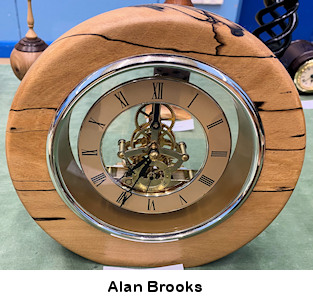
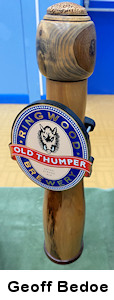
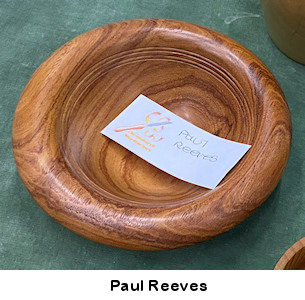
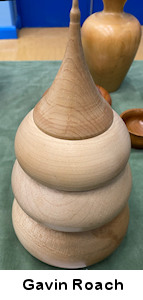
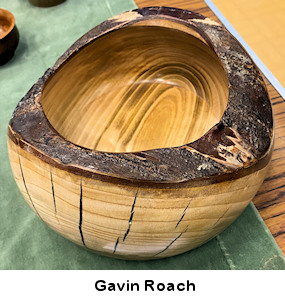
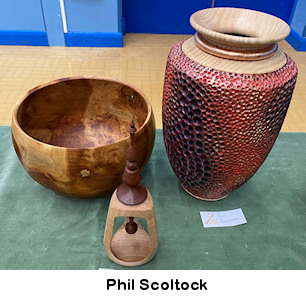
(click above for close up view)
Above are our two most recent New Members, who have brought forward some
interesting pieces.
◙Gavin Roach's box inspired from Balancing Stone sculptures was
turned in his first year of turning. Year two saw him turning this natural edge
bowl, which as suggested above, is a difficult project for beginners with its
vertical or undercut sides and for maintaining a clean cut on the bark rim
◙Phil Scoltock's large Cherry bowl was turned from the tree's crown
judging from the numerous knots, where wind and birds tend to drop stones, grit
and bits of metal like musket balls amongst the shoots, which
eventually engulf these foreign bodies and cause havoc to subsequent cutting
edges of gouges. His Ash hollow form was decorated with plain & metallic
acrylics and for the texturing, 4 different sized cutting/prickly balls. The
inside had been coloured dark which is a perfect way of masking anything that
might be considered unsightly!
The remaining items were of more recent productions, which are
shown below.
(click below for close up view)
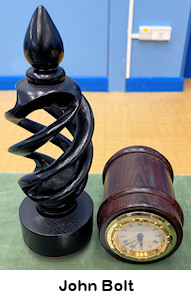
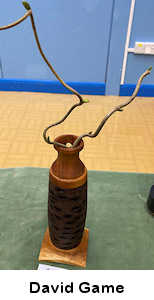
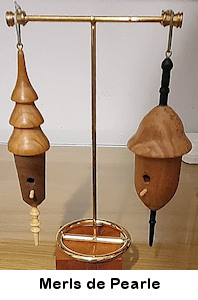
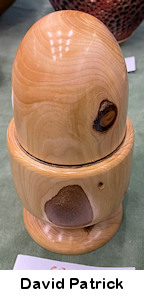
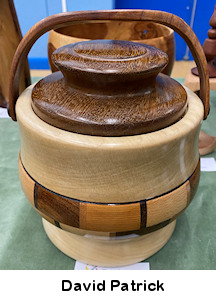
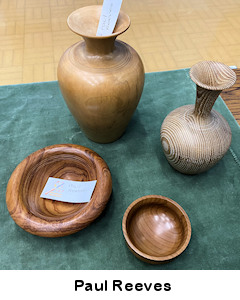
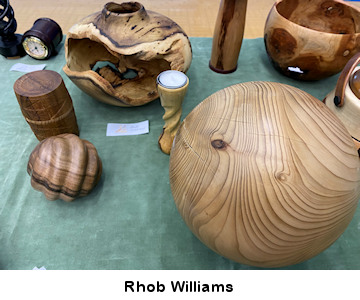
(click above for close up view)
TABLE A
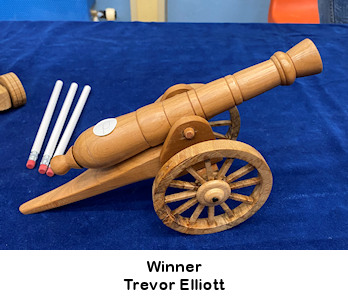
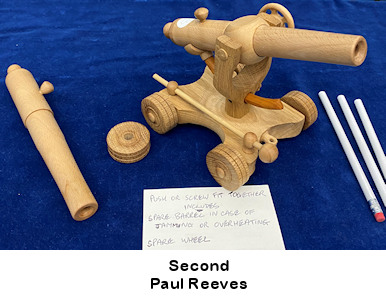
(click above for close up view)
The detail on Trevor's cannon was striking; his tyres and spokes
were of Burr Beech which must have been incredibly awkward to turn but
apparently it was the only suitable diameter timber he had to hand.
I think Paul must be seeking a Royal Charter with the spectacular 23
individually turned features of his shooter - if you don't believe it, click for
the larger view and count them for yourself.
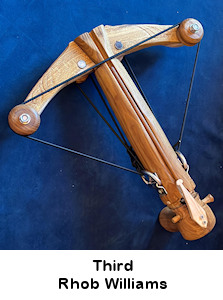
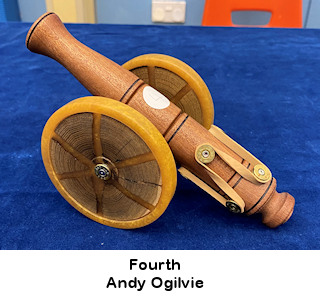
(click above for close up view)
Rhob's unique design was meticulously executed with sunken
hexagonal bolt heads, clever trigger mechanism and beautifully finished. It's
excess of power let itself down during the shoot-off regardless of selected
elevation due to the roof not high enough. (see Pencil Shoot-off below to sense
its size).
Andy decided upon a relatively simple single rubber band wound around .38 bullet
cases. His wheels were artfully created with resin in-filled with segmented
Laburnum branch wood.
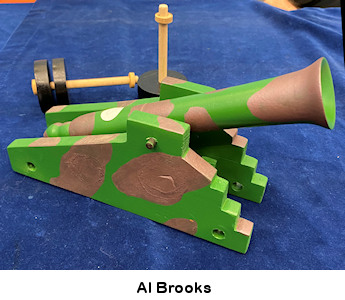
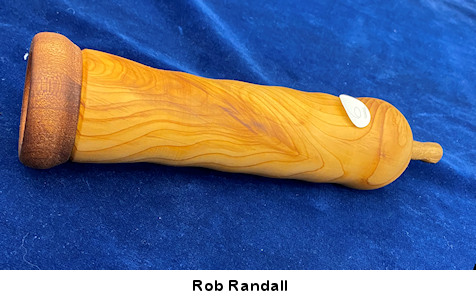
(click above for close up view)
Al's camouflaged shooter had wheels to get it here while Rob's hidden multiple rubber bands packed a significant punch as did John's exceedingly strong Parker Knoll springs which needed the winch to prime it.
TABLE B
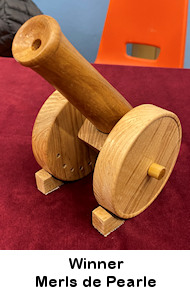
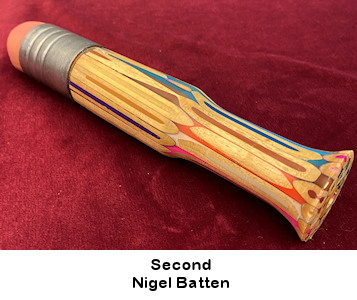
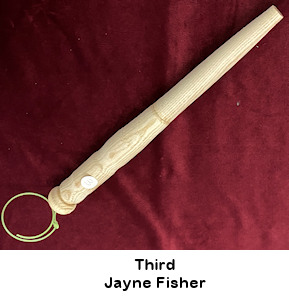
(click above for close up view)
Merls' spring-driven shooter ended up being the winner of
the Pencil Shootout.
To construct one's Pencil Shooter out of a mosaic of pencils was an inspired
design from Nigel but an internal failure prevented entering the shootout.
Jayne has only been turning for a matter of weeks and just a few days before a
holiday away from home to construct an entry. Despite not having time to finish
it as she would have liked, she still wanted to enter the competition, which is
exactly the example the Club is hoping for.
February 2025 -
Pencil Shootout
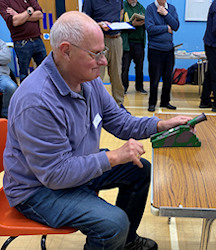
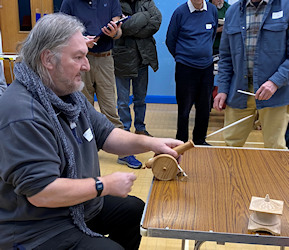
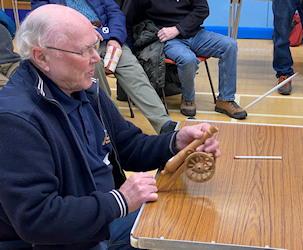
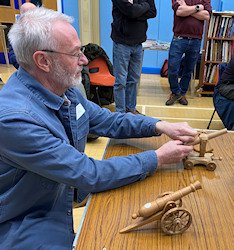
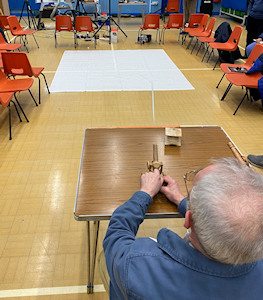
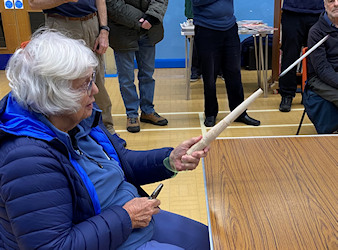
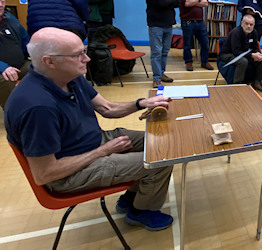
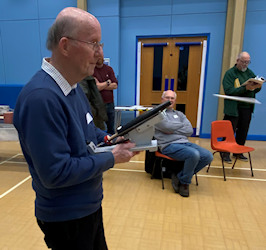
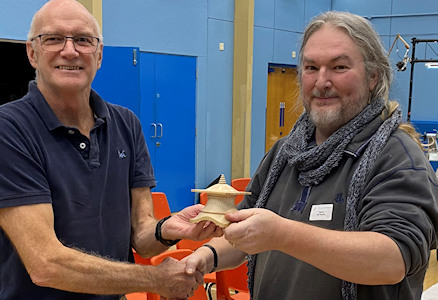

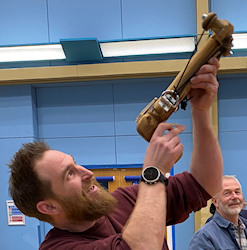
February 2025 -
Appraisal Table
with Paul Reeves
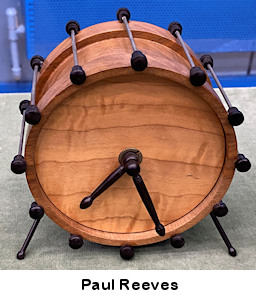
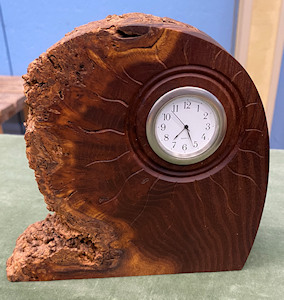
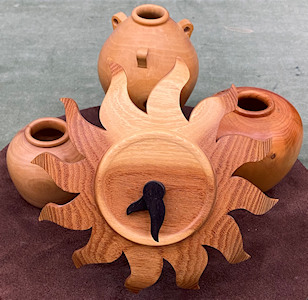
(click above for close up view)
In promoting tonight's Clock demonstration, Paul had
brought some timepieces turned years ago when the common challenge of what to do
with an interesting but awkward blank inevitably 'wound up' as a clock.
New member Jayne (from a senior generation) has been regularly to Paul's
workshop and this bowl was the second ever piece she has turned. Apparently she
is quite picky about her finish which is probably a good attitude to hold on to.
Allan's brightly coloured and sharp-edged Xmas tree is from a Monkey Puzzle
knot which turned like a resin, which in some respects is more or less what it
is.


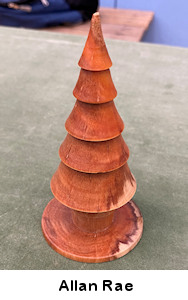
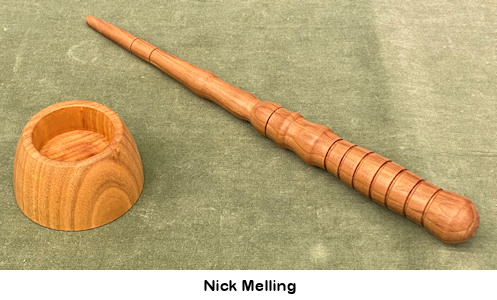
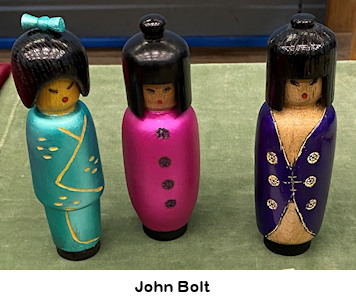
(click above for close up view)
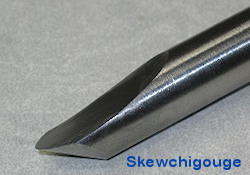 Nick is another recent starter who is clearly a fan of
Harry Potter looking at the wand he's made. The other piece is an alternative
design for an egg cup as his first cup of more familiar shape was considered too
unstable by his family. This shape had been done with an very old gouge with NO flute.
It sounded like Alan Beecham's Skewchigouge of the late '90s, which was a hybrid
Skew Chisel and Spindle Gouge that was forgiving when mishandled but dreadful to
sharpen accurately.
Nick is another recent starter who is clearly a fan of
Harry Potter looking at the wand he's made. The other piece is an alternative
design for an egg cup as his first cup of more familiar shape was considered too
unstable by his family. This shape had been done with an very old gouge with NO flute.
It sounded like Alan Beecham's Skewchigouge of the late '90s, which was a hybrid
Skew Chisel and Spindle Gouge that was forgiving when mishandled but dreadful to
sharpen accurately.
John's Kokeshi dolls (symbols of good fortune, protection and healthy wishes for children in Japanese culture) are decorated with iridescent and pearlised paints (as shown in
the click to enlarge photo)
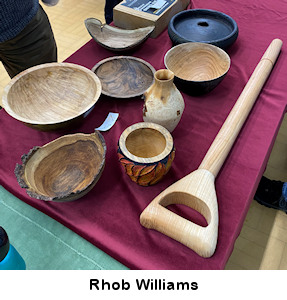 (click numbered
item below for close up view)
(click numbered
item below for close up view)
As per usual, Rhob had brought about a dozen new pieces for the table
including :
1.Japanese Maple (Acer Palmatum) was well worth turning over to spot the
spirit staining and Rhob's signature base design.
2.Natural edge
banana bowl in Holly - Normally, Holly is predominantly white coloured which
is the case of this sapwood but clearly the darkened heartwood has picked up
something from the soil.
3.Walnut bowl
- with a beautiful ogee shape.
4.Ash D-handle
- particularly dense piece of Ash, rather swish design because for reasons of speed
& simplicity, handles were normally T-bar so delightful to see the extra care &
attention.
5.Hand-carved & Painted
6.Scorched Hollow Form
7.Apple Burr Hollow Form
- with a window in the side which has shrunk as Apple readily does - so best to
be finished in one session.
January 2025
-
Appraisal Table
with Andy Ogilvie & Paul Reeves
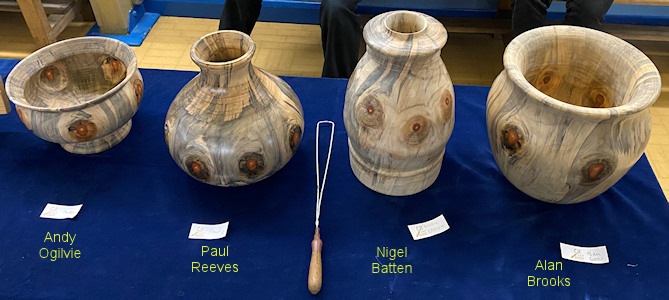
(click below for close up view)
<
Andy's > <
Paul's > <
Nigel's > <
Alan's >
The Club was fortunate to receive several pieces of
Monkey Puzzle from a donor in Lymington and above are a selection of end-grain
designs from four Members. All pieces have spalted spectacularly with
a blue-grey fungi, which is common in felled/dead white conifer woods although
Monkey Puzzle takes a much longer time to succumb to disintegrating, which is
probably why they have survived for the last 200 million years. The first
examples were introduced into England from Chile in Georgian times as Ornamental
Trees. These knots/eyes have a strikingly defined deep orange and this tree
seems to have developed them at identical heights which has resulted with all
knots appearing level at the outermost curve of each piece.
Andy's design has the advantage that both sides of each knot are in view.
He had put in a sharp edge which has taken well with this wood and he has also
drilled out the pith area and cunningly replaced a spare knot which won't shrink
or be at risk of dropping out. This was glued in prior to the final tool passes
which then disguised the join. He had finished with Howard Feed 'n Wax, which
has conditioning oils feeding the wood while providing a coating of Beeswax &
Carnuba which gives a flat finish without being over shiny. Ideal for this
wood but not for figured or chatoyant wood that need more gloss to enhance them.
Paul said he wasn't happy with his attempt as he feels it is too heavy
and will have a go with another piece which he will turn half this thickness now
that he sees that these blanks can take it. He remarked that if you are new to
hollowing, then this example would have been better turned the other way up so
that the majority of the hollowing is near the opening whereas when he hollowed
this out, most of the hollowing was at a long distance from the toolrest which
required steady and precise tool work with a long overhang. He finished with a coat
of Danish Oil, tickled with some 400 grit when dry before another coat applied -
he warned that it is too easy to wipe all the second coat away in one's cloth
when you must leave some behind to absorb and level itself off before setting.
Nigel had found it difficult with his small mouth design to remove the shavings
during hollowing so his piece took the longest time and was the heaviest.
Paul recommended using something like the bent wire hangar attached to a handle
(displayed in the centre of the photo above) as the best tool to clear out
shavings when hollowing, regardless of whichever tool one uses.
Alan hollowed out his with a Rolly Munro, which Paul commented that he
had successfully started his blank with a Rolly after fitting a new cutter and a
very fine gap setting. However, he found his original Woodcut (with a U-shape
cutter rather than the modern J-shape) gave better results, particularly as
these blanks were still slightly wet and cut more readily. He recalled that with
older very dry Monkey Puzzle, it had gone rather crumbly but he found hollowing
was better after allowing the wood to absorb water before the final passes.
(click below for close up view)
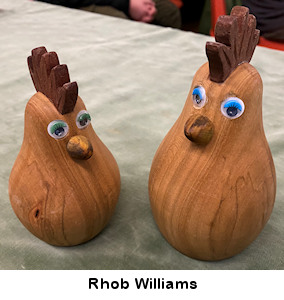
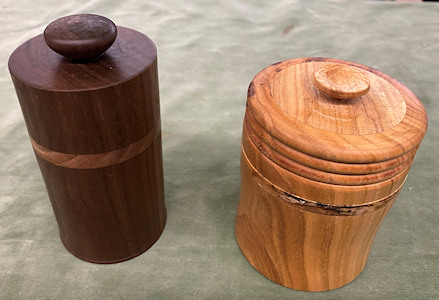
Rhob's fun looking Kellogg chickens out of a mixture of woods are quite
appealing with their stick-on eyes sunken into the wood. Continuing his
theme of mixed woods, one box comprising deceptively named woods of Black Walnut
with an inset of White Walnut (a.k.a. Butternut) from North America, which is
currently a species of concern following the spread of Butternut Canker since
the 1960's; and the other of Cherry with an inset of Japanese Maple.
His Birch circular bowl below has a hidden surprise of green ferns created in relief
on its underside (as seen in the enlarged view). The natural edge platter
is out of a figured crotch piece with its edge carefully highlighted with green
stain. Like all of these pieces, his square polished Yew platter also has
detailed decoration underneath from a Decorating Elf or a Knurling Tool.
Ian's Lime bowl had a marked undercut rim which makes it easier to remove
small items (eg nuts) as they naturally fall into your fingers when you draw
them up the side.
As reported last month, Finn had assembled a production line of 30 odd
pens within a couple of months which is a perfect way to improve one's tool
handling and finishing techniques.
John's fish platter wood sculpture is a pleasingly erudite design of
regular arcs centred on each corner but then transformed simply with colour.
The arcs were cut exactly the same way as in the Club's Multiple Centred Turning
Demonstration <here>.
Below is a troublesome piece from a plank of Silver Birch that was felled
because it had rotted up the centre so spalting had occurred in the sapwood
while the heartwood suffered from rot showing up as little white lines which
readily fell apart. Paul decided to persevere with some wood hardener, but soon
realized that he had selected an environmentally-friendly water-based product
that didn't penetrate much below the surface. He subsequently chose a spirit
version mixed with Sanding Sealer which penetrated far deeper and stabilized the
piece for turning and abrasives. One must allow time for solvents to evaporate
before buffing up when using a wax finish. Because solvents will dull a polished
surface as they evaporate, waiting until the following day will ensure an
enduring shine as all remaining solvents will have gone by then.
Andy got conned into believing that he was in a 'fun' challenge with some
other members to make a Spinning Top drive something else. When he stepped
forward with his effort, all the others seemed to have stepped back. The Top
with its pull string is held upright in the dished base with the aid of the
white PTFE counter with a matching hole in its bottom. Once the Top is set
spinning and the string & PTFE put aside, the Button Wheels can be placed on
opposite sides of the Top with their bottom edge against the base's rim and then
allowed to rest upon the Spinning Top, resulting in the two wheels going round
and round the base.
The left-hand box below is Walnut outer sleeve over a Boxwood insert. The walnut
had been hollowed first and then cut in a sinusoidal wave shape. The Boxwood had
to be carefully decorated with Andy's Ornamental Lathe cutters so that the
different sized circles would end up parallel to the gap of the Walnut wave
shape. The other wavy box is of Chanfuta (a.k.a. Pod Mahogany from East & South
Africa) with an insert of Beech.
December 2024
-
Appraisal Table
with Paul Reeves
Phil's Cedar bowl has an impressively thin rim which has
added strength from its drop-lip curve. The two large platters clearly took
considerable time & effort to complete; the Spirograph decoration was not
achieved with an Ornamental Lathe but rather using a Milling Head working off a
Compound Table for each circle while the zig-zag pattern is laboriously done
with a Router after carefully preparing the top to be perfectly flat. A couple
of inside-out Walnut vases; the larger the size, the more accurate tool work
required to get the openings to line up when 'remounted'.
Meanwhile, Andy has used his Evans Ornamental Lathe to turn two spalted
box with contrasting colours; one with spiral sides and the other with
straight fluting. Having been shown some examples of a 'Hans Weissflog' wood
shapes, Andy has adapted the idea with recessed components in his Turned Wood
Sculpture. The Club has been donated many knots/eyes from Monkey Puzzle trees,
which despite having a pith down the centre, are like an orange resin that turn
beautifully; Andy has created this ornament with three different shapes
fitted together. The smaller cone has spalted with a fungi's alluring blue-grey
pigmentation which commonly affects Monkey Puzzle.
(click below for close up view)
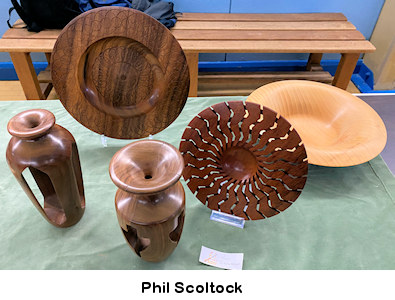
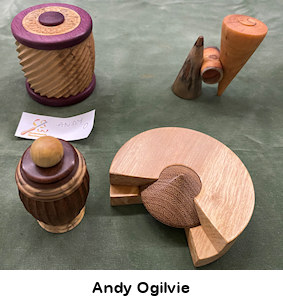


John's Potpourri pot makes an elegant statement for a table top.
It appears that Axminster's pen kits have been kept buoyant this Winter by Finn Trotman's countless number of pen turnings. This example is their Executive Gold
fountain pen kit
to a piece of Olive with interesting grain.
Trevor has produced a lot of elegant spindle work in the past which
these two finely turned miniature spindle-back chairs (30cm high) and his pedestal bowl readily attest. We weren't too sure whether
the right hand chair's seat with it's centred button was to deter children from
fidgeting or to punish them!
(click below for close up view)
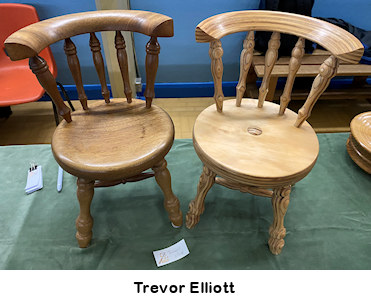
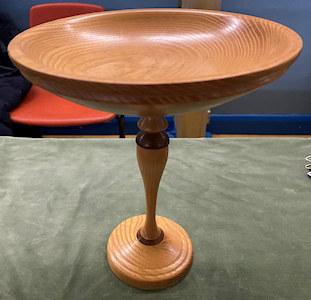
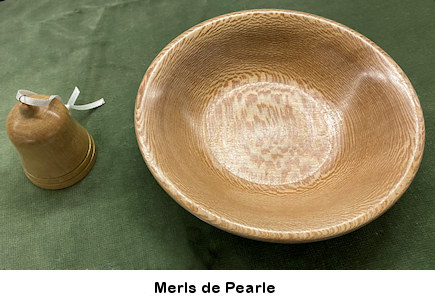
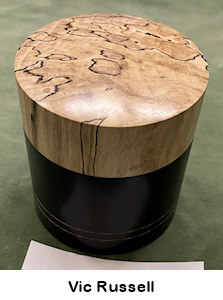
Merls' small lacewood-figured bowl of English Plane (more figured, less
pale and slightly pinker than American Plane) doesn't disappoint. When turned
from quarter-sawn blanks, the figure created by the Medullary Rays running from
Pith towards the bark, look spectacular while in their blank cut but prone to
disappear when hollowed out. This bowl appears to have been from a regular sawn
large trunk resulting in a striking finish. His delicate Christmas Bell tree
decoration is of Holly, but with an Ivy Wood clanger!
Vic's screw-top box looks as if it is made of two woods but in fact, the
base is of the same Spalted Holly as the lid but with a black stain through
which the spalting pleasingly remains just visible. For similar reasons to
Paul's preference to have a bowl's finish glossy on the outside and different on
the inside, this adds delight. The thread was cut with the Simon Hopeless jig;
Vic is still getting used to setting it up but looks very promising for future
projects.
Although Clive's wooden spalted bowl from a 30cm diameter branch had a
flat back from the bandsaw, relying upon hot-glue to secure it to a back plate
(in order to avoid any screw holes showing) was considered too unsafe with such
a large crooked blank. The chosen solution was to use two U-Bolts with extended
legs to pass over opposite corners and bolted through some thick MDF. Pieces of
folded lead were then screwed onto the MDF in a strategic place (found by
careful trial
and error) to balance the revolving blank and prevent the lathe from chasing him
around his workshop.
Phil's Gonk character is quite fun as a holder for his spectacles. The
snowman at its drum kit is a seasonal addition for outside the front door of his
toy Fairy House. The Laburnum low-lipped bowl is a perfect 'Show Me' bowl
formed to proudly display something special; an issue with the inside
undercut lip is to avoid gouging/scraping from the rim downwards, which is technically
cutting against the grain and tends to leave a pulled surface; for a smoother
finish, work from the widest point towards the rim. His Holly bowl demonstrates
the disadvantage of turning a 'green' endgrain blank because it shrinks on
average 10% circumferentially, 4% radially & about 2% in length; the bottom tends to
bow outwards and lifts itself off its foot and star shakes will appear in the
knots up the sides.
(click below for close up view)
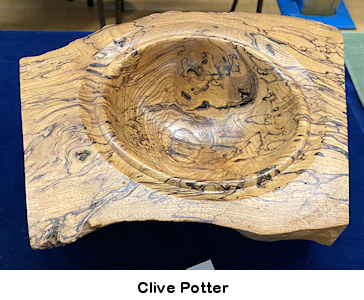
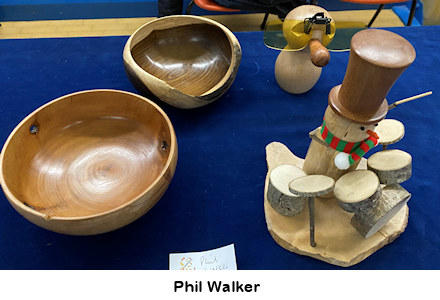
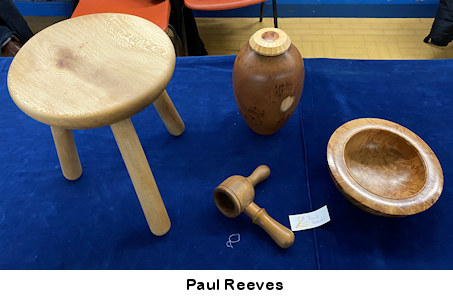

Paul's hollowed form Yew turned end grain is surprising light
weight with walls about 4mm from top to bottom; the threaded Boxwood lid had its
facets done on his ornamental lathe. An eye-catching figured bowl
turned from one of the American Maples donated to Paul by Mark Baker. An
old design nut cracker and a child's 3-legged stool for a forthcoming gift for a
little girl.
In the right hand photo, the bulbous spalted box is small and was kept light
weight by turning the walls down to a couple of millimetres because a small box
feeling heavy is always disappointing. The adjacent threaded box is a prototype
idea for a travelling ring box with some spongy felt washers to protect the
contents from one another; the lid holds the caddy's handle centrally secure
when closed but when opened, the rim of the caddy's base has a thread which will
grip the inside screw thread at the top of the box when lifted, leaving both
hands free to select the desired jewellery.
Below, the spalted bowl is endgrain turned and like so many before, had shrunk
to a misshape with the bottom blown out despite the blank being left to dry and
originally from a long time dead Sycamore sawn down the previous year; the
spalting is particularly impressive and had formed while the tree was growing so
might even have caused the disease that resulted in its demise. There are two nut crackers of similar workings but
the left one was specifically designed for the elderly who find it easier to
grip & turn a squared handle; its thread was produced with a Screw Box & Tap (method
described in Archive webpage
<here>)
so the best method for getting the handle to line up square with the body when
fully closed was to use a separate Boxwood thread insert glued into the body to
achieved such. He had made a Nail Puzzle with nails of Laburnum heart wood which
is normally too hard for woodworm and certainly won't rust! Lastly, a selection
of different coloured pen kits as a trial display of available colours; Silver,
Gold, Anodised Green Red & Blue, Chrome, Gun metal and Black Chrome currently
available from Amazon and others; finish was achieved with a slow turning lathe,
wet a small piece of cloth with thin superglue and apply an even coat by moving
slowly along the rotating barrels while keeping your fingers away from the wet
area of the cloth of course; when the end was reached, the
piece was left turning for another 20 seconds to dry; a light sanding before
applying another coat; sanded again to 800 grit then treated with U-Beaut EEE,
Hampshire Grit or similar, followed by a light coat of wax over the top.
This is Julian's second project using his recently purchased Roly Monro
hollowing tool and is a piece of Leylandii. He seems to be getting on rather
well with it.
(click below for close up view)
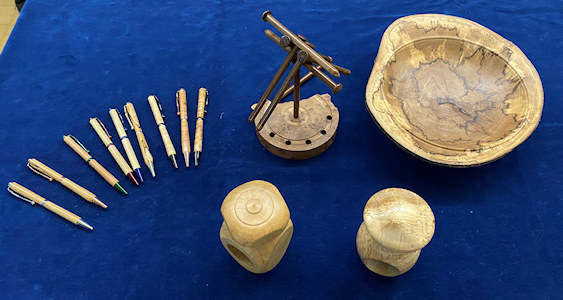
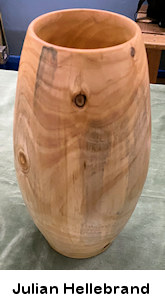
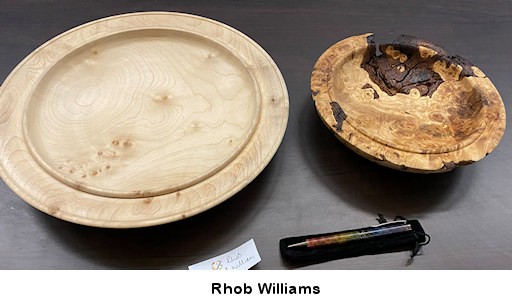
Apologies to Rhob but we weren't able to discuss his pieces because he had to collect his work and leave early.
November
2024 -
Comp 4
Jewellery
TABLE A
(click any below for close up view)
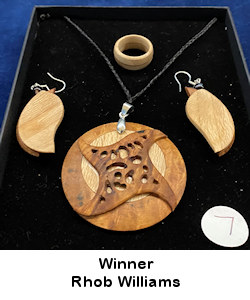
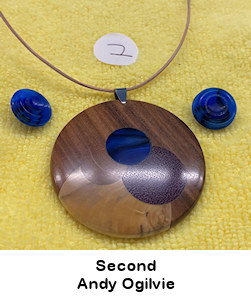
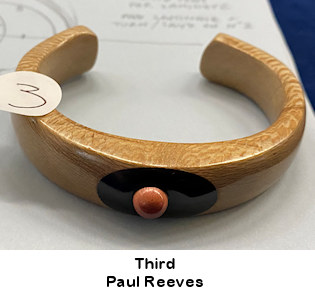
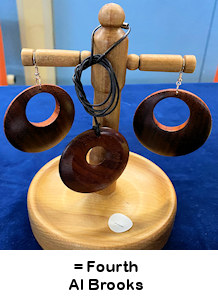
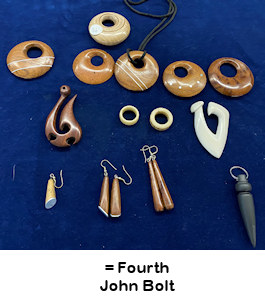
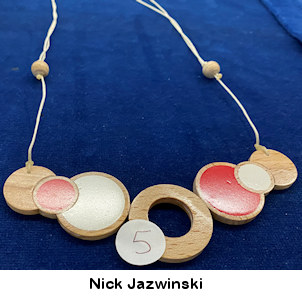
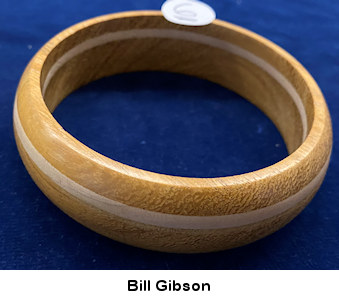
(click any above for close up view)
Prolific entries from individuals with some worthy of further details :
♦
Paul's bangle laminated with resin and Pink Ivory were calculated using Golden
Ratio proportions for their thicknesses and the various centres of arc were
selected so the piece became oval with a thicker top section while the opening
could pass sideways over the narrowest part of the wrist. His workings can be found upon
clicking the photo.
♦
John's 'fish hook' shapes in his central row are his copy of traditional Maori
jewellery; he made the white piece from cow bone while the ivory looking rings
are from Tagua Nut, which many describe as 'vegetable ivory'. The smooth
dark grey pendant is of slate.
♦ Nick's necklace with epoxy & ceramic insets was length adjustable via the two
stringed spheres further up the cord.
♦ Bill's bangle was of a Maple laminate.
TABLE B
(click below for close up view)
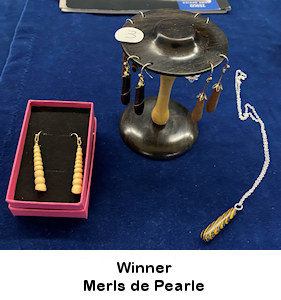
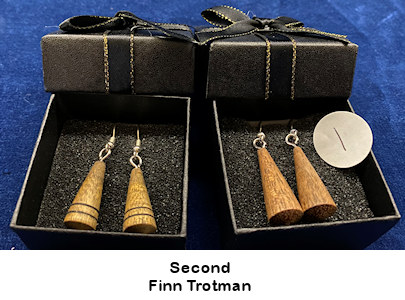
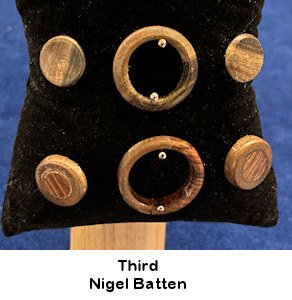
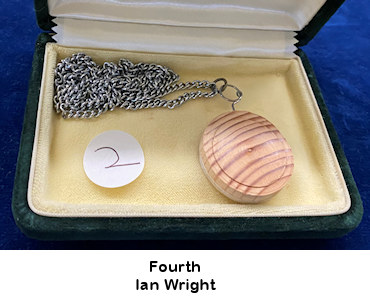
(click any above for close up view)
November 2024
-
Appraisal Table
with Paul Reeves
(click below for close up view)
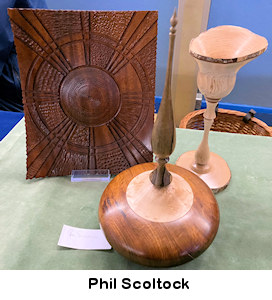
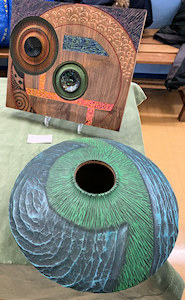
Phil had several items; a
hollow form with a nicely fitting lid in Bird's Eye Maple decorated with an
elegantly proportioned finial of Black Limba (more commonly used for electric
guitars) - although these days the Health & Safety Executive would probably
wince at the pointed top; a natural edge goblet from a branch taken off one of
the American Ironwoods; a square platter of an attractive wood with straight
cuts of a router to divide the space and textured with various knurling and
cutting tools; a coloured collection of various designs
which is a good method of keeping an index of which finish and colour look good
together. An eye-catching and clearly painstakingly carved hollow form with metallic
highlight finish, cut from an end-grain blank. Paul warned that turning pieces
with the pith in, risks the tendency to move (invariably outwards) which leads to
a wobble and only dealt with by remounting.
Finn has been busy with turning the family's Christmas presents; a
Bedside Clock and a Rosewood Box for his Nan's sewing needles.
Andy's White Walnut square rimmed bowl had been a contender for some
resin infill in its larger blank but the grain was so attractive, he turned away
the rough parts and ended up with this beauty; one of his two boxes had a choice
of lids - a domed shape gave an oriental feel while the flatter shape resembled
a ginger jar.
Al's offset pendants avoided having their lanyards through their holes
but instead via appropriate sized drilled holes for a neater effect.
Rhob has been perfecting his inside-out turning along with some resin
mixed balls; he is also ahead with his output for the local Christmas fayres.
Paul's large Sycamore bowl had proved difficult to bowl save with his
Woodcut system which for this size blank, could only reach inwards to leave a 3" central connection.
This was too much to separate and still ensure not losing the outer bowl so he refitted with his Kelton McNaughton system, which although had a different cutting arc, did manage
to reduce the central stub enough to prise it off without risking the bowl's
bottom becoming too thin. The other 4 Cherry bowls were from 2 blanks and a lot
simpler to bowl save. Paul likes to buff just the outer surfaces which makes for
a different appearance with the insides, both visually and tactilely.
The goblet had been decorated with the Veining Chisel (used in tonight's
demo), and a project he had failed to waterproof successfully. It was a case of choosing
the wrong wood for the job; Elm grows with very open pores. The piece of Pink
Ivory was originally a spindle with a thread on the end to screw-mount into a
Jam Chuck to turn buttons, finials etc; rather than waste the last piece, he
trimmed & decorated the Ivory as a lid and the Jam Chuck into a small pill box.
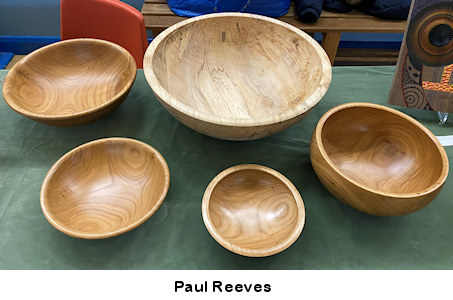
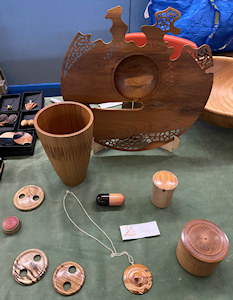
(click any above for close up view)
Paul finished with a challenge project he had in mind for his Wife Greta, who regularly pins her hair up. The design needs a fine light-weight hair grip, perhaps using a 'banana bowl' technique with natural edge, similar in style to the one below, but strong enough for a pin to hold the grip in position without slipping through the hair.
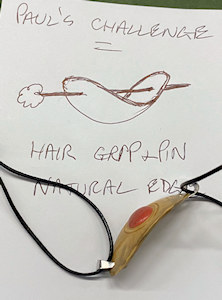
(click above for close up view)
October 2024
-
Appraisal Table
with Andy Ogilvie & Paul Reeves
It's always lovely to welcome new Members but it's not often the Club is fortunate enough to attract such accomplished work as displayed by Phil. Clicking below for a closer view underscores his skill and attention to detail with specialist tools like laser levels, precision borers etc; they were a delight to examine at the table.
(most of below can be clicked for close up view)
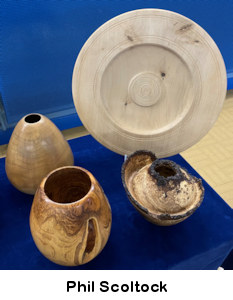

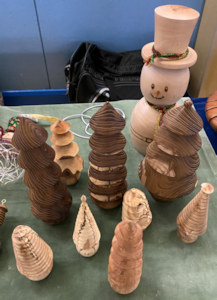
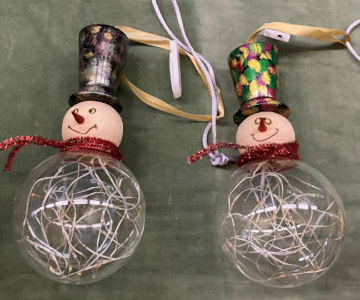
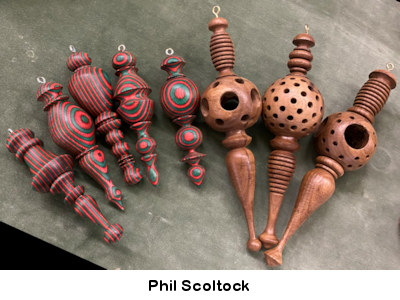
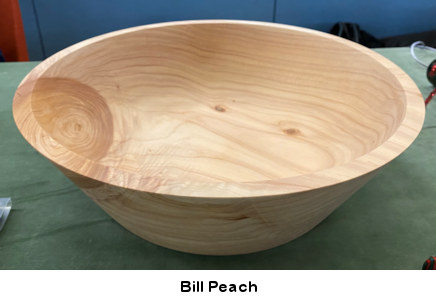
Bill's Macrocarpa bowl still has a fragrance, although Paul
prefers to avoid its smell and dust as it can leave him with skin and
respiratory irritations. It's a wood that needs care when sanding as it quickly
clogs and heats up causing marks and cracks. This example has been done cleanly
and very well.
Vic's German style 'Smoker' appears to be at an Axminster Trade lathe, which
demonstrates the extent of time & effort he spends on detail. Did you spot the
hollow form under the lathe? He displayed some of his Mitre Boxes and templates
used for repeat components.
Andy's decorated bowl was achieved by pouring in green
resin followed by 8 spots of red and then by black resin poured into the centre
of the reds. Following suggestions from Ceramists in the family, Andy plans to
experiment with dragging one colour into its neighbour. In response to last month's Bobbin turning
demonstration, he produced a matching pair of Lace Bobbins from Purpleheart on
his Ornamental Lathe which received great acclaim from the demonstrator, Merls
de Pearle.
Putting forward appraisal of ones woodturning on the table for the very
first time can be nerve-wracking for many, so it was pleasing to see such from 2 new
Members from opposite ends of our age demographic. Finn is one of our youngest
Members ever and this snowman was his first effort after some Club tuition.
Likewise, after a working life of producing commercial wooden artefacts with
saws & chisels, Mike turned his first bowl (although he still refuses to give up
the day job!)
With Halloween fast approaching, Ian had dusted off his
Flying Witch while Alan had produced a Witch Smoker that is best viewed by
clicking the picture to discover the spiders, cat, hairy warts and all in full detail.
Rhob had another prodigious month's work with a String Holder for Club
Sales and 3 natural edge bowls, all having crisp edges with the aid of a
goose-neck Cabinet Scraper (just visible behind the back Walnut bowl) which was
used to dress out the torn grain of the inside curves, right up to the rim which
avoids the chance of abrasives ever having to touch the natural edges. That
Walnut bowl was particularly thin walled, which inevitably shrinks at a
different rate to the the bark edge and would start to separate. This had been
prevented by soaking the inner bark (Phloem) down to the Cambium cell layer with
thin superglue. The spun-colours bowls are best to be done inside a cardboard
box unless one wants to redecorate the workshop. The brown bowl at the back is
of exotic wood, Wenge, which would have furniture makers turning in their graves
to see so much beautifully grained wasted shavings on the floor just for a
turned piece. Wenge is extremely hard and needs to be more engineered into shape
rather than gouged. Some blank dolls had been left for a 2 year old to paint a
face and clothes to her mind's content as Christmas ornaments. A Giant Redwood (Sequoiadendron
giganteum) scorched hollow form is perfect for Shou Sugi Ban charred wood
finish because it readily brushes out the softer Summer growth between the
harder growth rings. Paul advised that to get the beading evenly blackened, you
should choose from staining, marker pen or spray painting with an eboniser.
Rhob's bowl with resin embedded with Larch fir cones when
the rim of the bowl was a lot higher allowing a deep trench to contain the cones
& resin before subsequently being trimmed back to leave the resin at the bowl's
highest point.
With Christmas around the corner, Paul had brought in a selection of ideas
(mostly from previous demonstrations) with the reminder that if one used a real
candle in a tea light, it should be encased in a non-flammable holder; or
better, use a LED version. He had also brought an old Walnut deep platter (regularly
brought out for Christmas nuts etc) with golden stars encrusted in a scorched
rim that had been turned many years before and had certainly moved with age as
it had dried out. A platter will have
opposite sides where a gouge has to cut across the grain. When the gouge cuts
down the undercut rim in these end-grain sections, you are technically cutting
'uphill' which will result in a roughness caused by the tool tip pulling the
grain out. No amount of abrasives will smooth this without sanding far more away
from the softer along grain sections. However, with such a large diameter as
this, Paul used a small handled spindle gouge which he could cut from the
deepest part of the undercut up to the rim edge and therefore cutting 'downhill'
to create a smooth tool cut.
And finally, John had brought in a spalted box in the Chinese style of only opening when the correct slither of wood is removed, two interlocking snakes forming a Rosewood trivet and a cleverly segmented Nautilus shape.
TABLE A
(click any below for close up view)
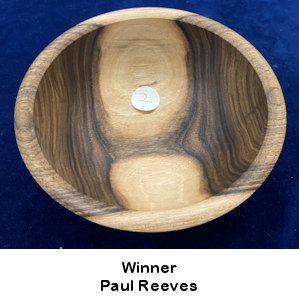
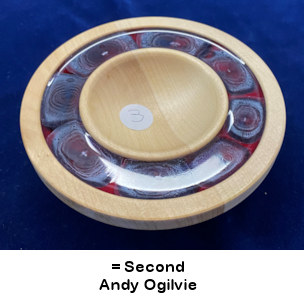
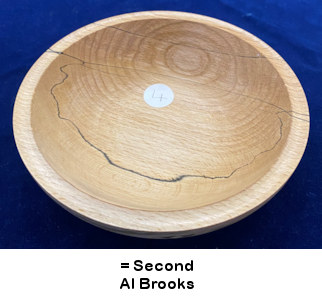


TABLE B
(click below for close up view)
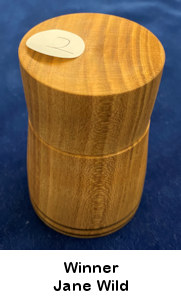
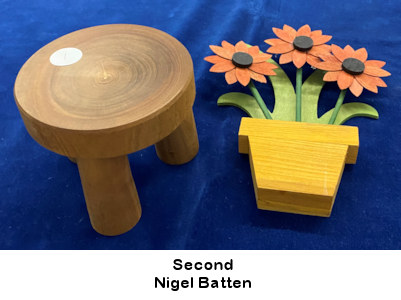
September 2024
-
Appraisal Table
with Paul Reeves
Phil's Yew vessel was a brave piece to tackle as there wasn't a
lot of wood holding the piece together once hollowed to as thin as seemed safe.
Allan's Walnut bowl with its Celtic Knot style decoration demands a difficult
shape. The outside has been done nicely with a good foot but so much flat space
for the rim makes it difficult to undercut thinly enough to keep the weight down,
made even harder because of how a tool cuts/tears differently along softer side
grain and harder end grain. The pattern had been printed on paper to the
required diameter before copied onto tracing paper to transfer the outlines onto
the rim. Then the blackened pattern was laboriously produced with a Pyrography
Machine using Ball and Knife Point heads.
(most of the below can be clicked for close up view)
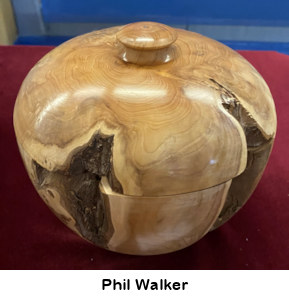
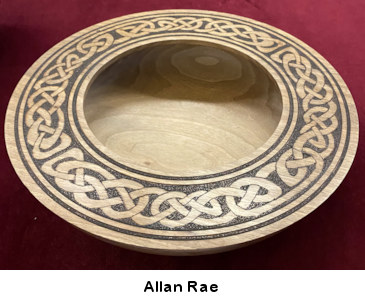


Al's Burr Ash bowl was beautifully finished to show off its pattern. Paul recalled the procedure of final cut of a bowl surface described in the recent 'Straight from Tool' demonstration (available <
HERE>) which was Sanding Sealer to lift the fibres, reverse lathe direction and cut/shear with tool on other side of the rails. Recent new Member, Jane had turned a tricky natural edge
with a satisfying shape. Paul commented that many turners attempt to make the
ends too steep which creates difficulty cutting the inside surface; better to
leave the high points flaring outwards to help keep the edge thickness even all
over. This can also happen if the piece moves during drying, particularly if you
work the inside days after turning the outside. When the edges are already thin,
a 1mm shrinkage is far more noticeable. He also commented that despite achieving
sharp rim edges with her gouges, in some places they had been rounded off, most
likely by sanding with the lathe turning and/or not using a flat pad held
perfectly vertical.
Paul described how his "scruffy old" Walnut bowl had been turned several years
ago and finished with a food safe oil. He had recently knocked the oil finish
back to a fine smooth surface by hand with 0000 wire wool and after a coat of
Renaissance Wax, this was the result.
Rhob has continued with upmarket pens/pencils; his Catalpa (aka Indian
Bean Tree) wood bowl turned nicely but won't take detail easily;
Rhob keeps up with enlarging his hollowing experience -
it's a long adventure to get the inside cut smoothly although Paul recalled
himself masking inside his early attempts with matt blackboard paint because
without internal reflections, one couldn't pick out blemishes. Next was a bowl made of
Box Elder wood, which Paul enthused about its natural tendency to ripple, its
chatoyant lustre and that it often has an attractive pink streak which fades over time although some
people have the pink permanently painted in. Rhob's Continus box (aka
Smoke Bush Tree) is another attractive wood.
Rhob had brought in a Yew & Resin medallion together with more of his
Birch Burr, but this time treated with a stain; The cut-out leather works as a
home-made Jam Chuck with a spigot on the back to fit his jaws. Paul
considers Rhob's 6" tall hollow form as the perfect size to practice hollowing;
making the opening small is another way of masking your finish inside. Finally,
his spinning toy top was embellished with a Decorating Elf and he learnt that sanding
a
top
interferes with it working well. Paul commented that it was inevitable to sand
one side more than the other and that would lead to wobbles.
August
2024 -
Appraisal Table
with Andy Ogilvie & Paul Reeves
(most of the below can be clicked for close up view)
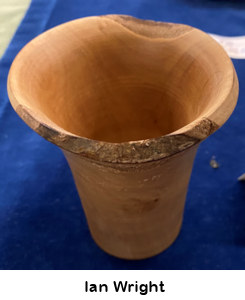
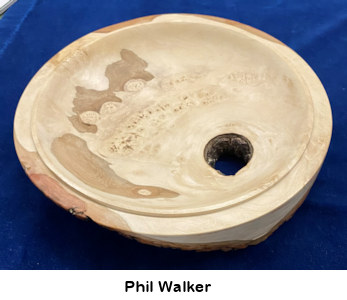
Ian's pen pot was a Cherry branch turned from wet.
Phil's unusual bark covered underside works well with making use of an ancient
branch long-time lost to leave an interesting feature.
Meris de Perle is still working through more 'punky' blanks donated to him. A
small bowl with vastly contrasting densities had resulted in the tenon
collapsing twice and all requiring a lot more time than his customary Bobbin
turning. A salty piece of flotsam driftwood found on Hengistbury Head turned up
surprisingly well when mounted upon a re-purposed old-fashion bell push.
Allan's raft of ducks created considerable interest with their well-fashioned
tails.
A perfect sphere is the simplest form of a "body of constant width in all
directions" (known as an 'Orbiform') but there are many unexpected shapes that
also satisfy this definition. Andy has turned an example of the first
alternative discovered although there are more sophisticated orbiforms
incorporating triangles, pentagons or heptagons as their background shape.
While we were talking of punky pieces, this initially perfect cylinder was from
a blank cut across the trunk (just missing the pith) and turned thin when very
green so that the drying out created uneven shrinkage movement. This effect is
even more pronounced when using a similar cross-section of branch wood, which
tend to have pronounced reactionary growth above the pith to compensate for the
tension of the bending force due to the branch's weight. Andy's Holm Oak hollow
form was another across trunk blank but this time incorporating the pith. An
attractive change of grain but awkward to hollow out. A Milk Pearwood cap turned
on his ornamental lathe distracts from the over-weight form and on its own,
would be a fine candidate for tonight's 'Straight from Tool' competition as no
abrasives were necessary.
Vic has been machining some hollowing tools fitted to a 6mm cup cutter. As
remarked in his April 2023 Pro-Demo, Les Thorne was always surprised that the
smallest diameter scrapers seem to be the quickest to remove the inside, which
Andy could attest after he had a go with Vic's version in his workshop.
Rhob's Cedar stool was an example of 'Shou Sugi Ban' style. The more torching
the piece, the more the softer grains are burnt away leaving deeper ripples.
This was a tall stool which accentuated how flared outwards were the legs. Paul
advised that 15ș is about the limit to reduce the chance of a leg breaking at
their tenon.
Paul's Burr Oak stool was smaller (but then he's not as tall as Rhob!) and the
top was purposely left flat so it could double as a side table. He also
highlighted that he prefers to hollow out the underside of the seat to reduce
the weight of the piece and not have the legs coming through the seat top in
order to be wedged into place. His Rippled Ash hollow form was
turned more than 10 years ago and even the woodworms had moved on. He has
eventually finished with Walnut foot & lips, decorated, oiled and then buffed.
He finds the matt interior and glossy outside particularly pleasing.
His spalted bowl has regular tool ridge marks on the inside which Paul
deliberately left as he felt they added to the appearance and have the extra
property of a "tat-tat-tat" noise as one spoons the milk out of the bowl. His
other items are all utility boxes with a little surprise within; 2
Paraná Pine
needle cases, a rippled Yew box and a screw-lidded acorn. Paul commented that he
only uses a short number of threads so that the lid removes comfortably quickly
before he forgets what he wanted to open it for.
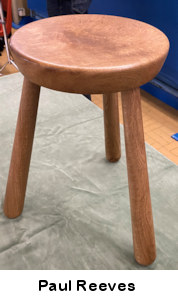
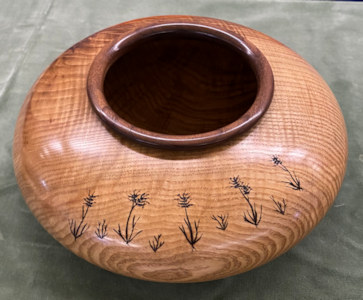
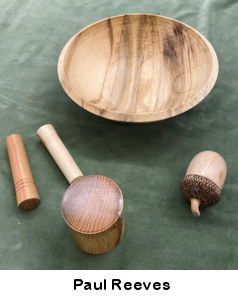
(most of the above can be clicked for close up view)
TABLE A
(click any below for close up view)
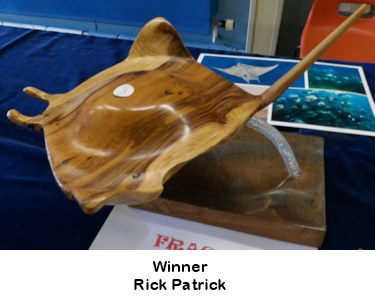
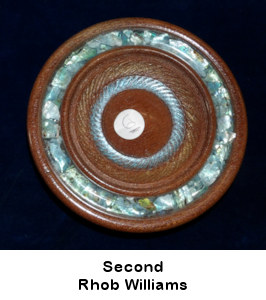
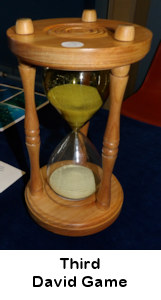
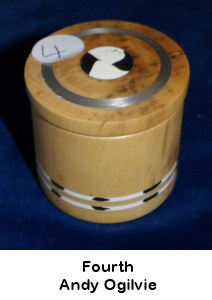
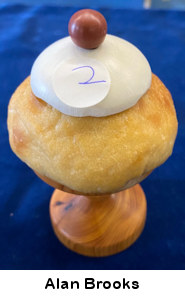
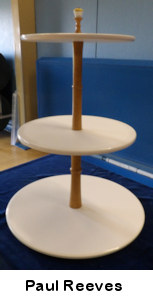
(click any above for close up view)
Rick's Mobular Ray (aka Devil Fish) was taken from a damaged flitch of Yew
with another piece of Yew sapwood glued on for its tail. The other solid
media was a rod of clear Acrylic with purposely captured bubbles to represent
the seawater. The curve was accomplished within boiling water.
Rhob's bowl had pieces of New Zealand Paua shell embedded in clear resin with
matching decoration using a Decorating Elf in and under the bowl.
David's Egg-timer was about 12" high with its ends finished with carefully
matched decoration.
Andy's Boxwood box was part of his demonstration showcasing multicoloured
Milliput.
Al's Iced Bun has real bread as its other media. During lockdown, his Wife had
experimented making bread rolls but an early attempt presumably got an awry mix
of yeast which he has now bravely(?) incorporated into his competition piece.
Paul's tall cake stand was originally made for a commercial kitchen and designed
so that the plates threaded down the central spine for ease of storage. The
alternative media (looking a little like Corian) were turned and sanded from a
experimental piece of research for a light-weight composite material suitable
for an aircraft galley; but it never got off the ground due to it failing a
non-flammable test. The cake cup finial is inedible.
TABLE B
(click any below for close up view)
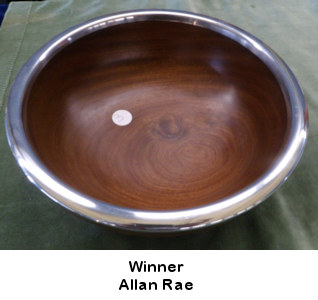
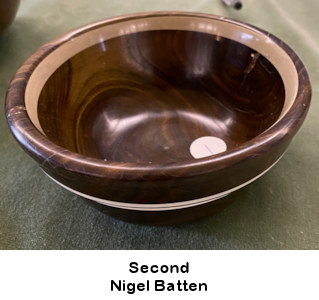
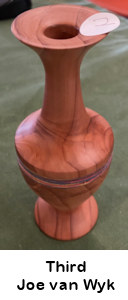
(click any above for close up view)
Allan had created a T-shaped cross section mould for his molten Pewter which
subsequently fitted into a matching slot turned into the wooden rim top.
Nigel's piece started off as a Lignum Vitae bowling ball, which had been clearly
well used judging by the many shakes within from smashes into opponents' woods.
The other media was Milliput decoration. The internal cream band was an
experiment of Milliput mixed with Copper powder; he was hoping for slightly more
metallic finish but will try with more powder next time.
Joe's unusual media was coloured string around the belly of a nicely
proportioned bud vase of Coastal Redwood.
July 2024
-
Appraisal Table
with Paul Reeves
(some of these can be clicked for close up view)
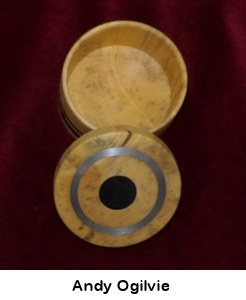
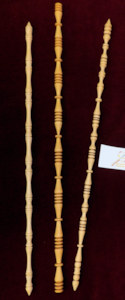
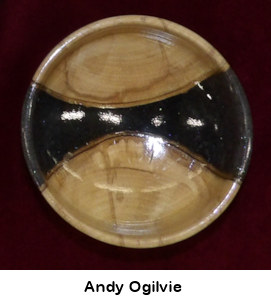
Andy's Boxwood box was the finished piece for his first mixed media
demonstration with single coloured Milliput and soft metal alloy while the glitter laden resin bowl was his second demonstration as finished after taken
home for final abrasives and a gloss lacquer. The 3 spindle worked pieces were
turned without the need of centre-steady by using Pin or Pen chuck jaws to
secure the dowel coming through the head stock and just working a short distance
from the jaws; eventually the turned areas needed support while wrapped with
safety cloth and threaded through the tail stock.
Paul had produced 6 examples of branch wood he had turned to complement
his demo. His 4-legged stool is a scaled up version of tonight's demonstration
with a banana shaped seat out of Leylandii, put to Laburnum legs carefully
angled diagonally to maintain their strength. He has also been building up stock
of Kururin Fidget Sticks for Club Sales at forthcoming events; these have been
decorated with aluminium nails that he had found perfect for turning and sanding
to a fine finish, particularly with a dark coloured wood. Next was an example of
traditional Japanese scorched wood technique known as 'Shou Sugi Ban' often used
as cladding for barns which are then treated with Tung Oil to make them rot,
weather and waterproof; the Japanese commonly use Cedar but this stool of Coast
Sequoia works just as well; Paul recounted a tale of a scorched plank lining a
compost heap that was still there 20 years later proving the technique indeed
works.
Alan's burr bowl was a mystery grey uninspiring wood blank won in a
raffle which dazzled upon turning; the consensus was that it was probably a
Birch burr; just goes to prove not all 'gift horses' are Trojan.
Paul's footless burr bowl is of rarely seen Nothofagus (southern
hemisphere Beech) which had a lot of dead wood on the outside that Paul wire
brushed to a lower layer leaving the sound wood polished. His candlestick
bookends are another example of branch turning; the branch was cut in half, hot
glued back together in order for the lower main body turned leaving space above
and below the base; then divided and remounted individually to turn a spigot on
the bottom and the candle cup on the top; the spigot was held to hollow for the
candle insert.
Rhob's Cherry bowl had truly random carving on its side and a wavy insert all accomplished with a rotary band saw, Dremel and a lot of time and care. His Birch bowl had striking parallel angled carvings achieved with a router while the piece still mounted on the lathe; finished with dark oak stain. His hollow form was of Continus (aka Smoke Tree/Bush) and about 4" tall which Paul described as the ideal size to perfect one's hollowing skills.
What Rhob had intended to be a table top was remodelled to a skilfully
flat platter with a simple bead highlighting the opening and an unexpected
decoration in the foot.
David's 12" high inside-out vase was another dedicated laborious turned
piece with impressive results that reflect his joinery workshop background.
Nick's two-tone platter was taking advantage of an old piece of brown
furniture plank which he subsequently considered a little dull, so inserted
Beech as a contrasting colour; his main regret was that he didn't think of
aligning the two grains until it was too late.
(photos by Andy Ogilvie, Rick Patrick & Paul Reeves)
TABLE A
(click any below for close up view)
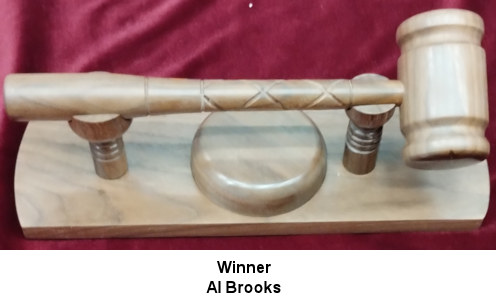
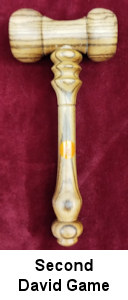
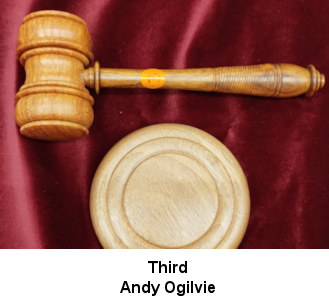
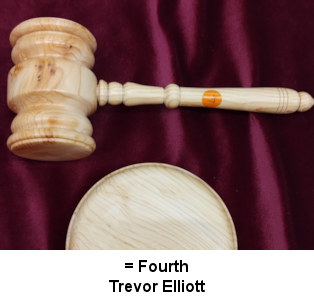
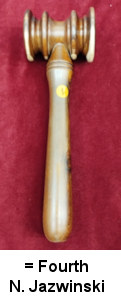
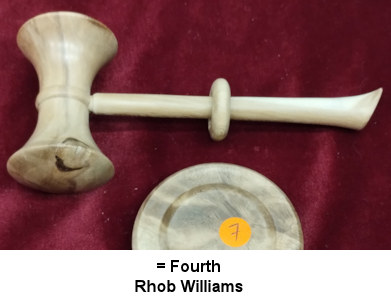
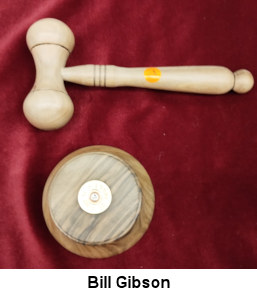
(click any above for close up view)
TABLE B
(click any below for close up view)
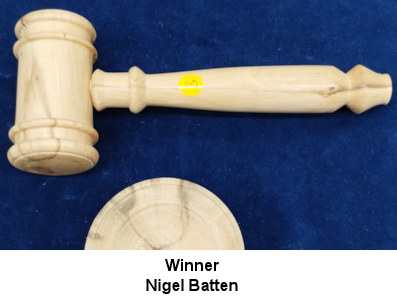
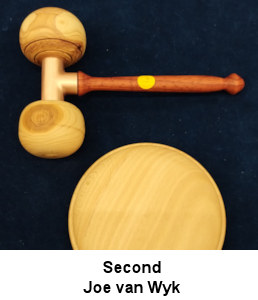
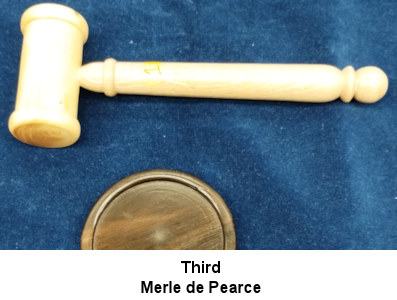
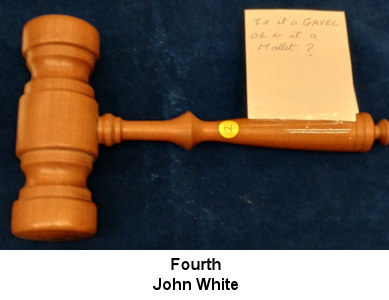
(click any above for close up view)
(photos by Dick Bugg)
June 2024
-
Appraisal Table
with Andy Ogilvie
(some of these can be clicked for close up view)
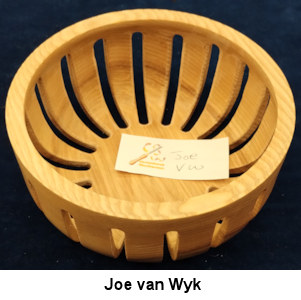
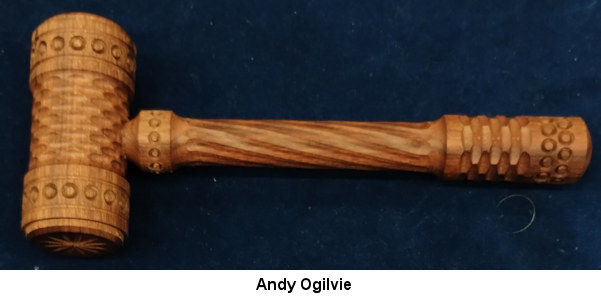
Joe's basket bowl slots were
achieved with the piece locked in place and a router supported as it was guided
around.
Andy had found the Gavel competition as an interesting project for his
ornamental lathe making use of 3 different procedures of drilling, sculpting and
spiralling.
Al has been turning some long stored wood blanks; a Laburnum bowl; a Silver
Birch Burr natural edge bowl which had a lot of rotted wood to be removed before
he finalised his shape; and an Elm platter from a tree cut down more than 30
years before and required an oblique cut out of a large block to obtain this
blank.
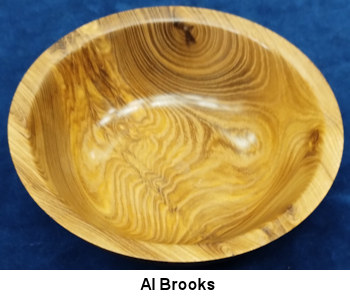
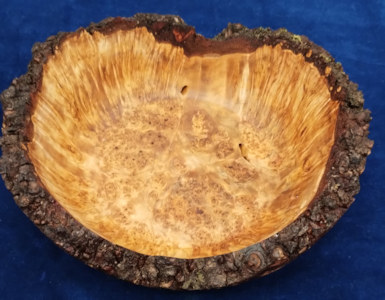
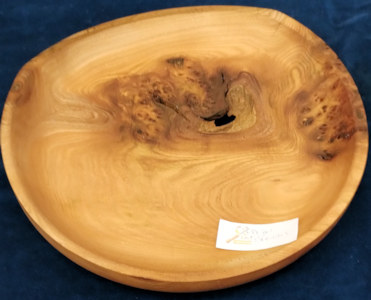
(some of these can be clicked for close up view)
David's Oak gavel had an interesting
design with one head rounded for use when gripped in the palm of your hand and
the opposite head being flattened for knocking down on a block.
John had used this family heirloom as a basis of his Gavel Competition entry. It
has a cartouche inscription stating it was used to lay the foundation stone of
Cambric Chapel in Cornwall circa 1890. Another example of different shaped
heads.
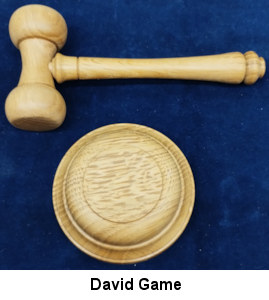
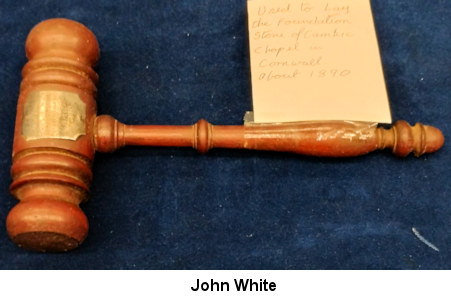
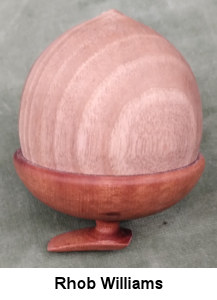
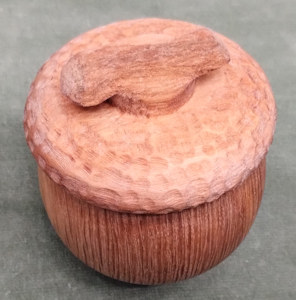
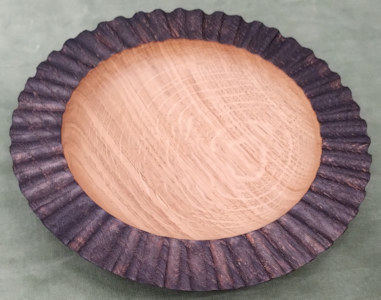
(some of these can be clicked for close up view)
Rhob continues to enthral with so
many pieces he brings of interesting examples of wood and technique. His
competition piece was of Garrya Elliptica (aka Silk Tassel Bush) which most
present had never come across and his two fine examples of Acorn Boxes with
screw lids, both incorporating extra interest with miniature tops/mushrooms
within, bear witness to his turning skills. A torch blackened bowl decorated
with indexed routed grooves.
A natural edge Yew bowl demonstrating Rhob's skill at seeing what can end up
such a fascinating piece from out of a tangled mess of Yew branches grafted
together by nature.
A shallow bowl coloured with embellishing wax.
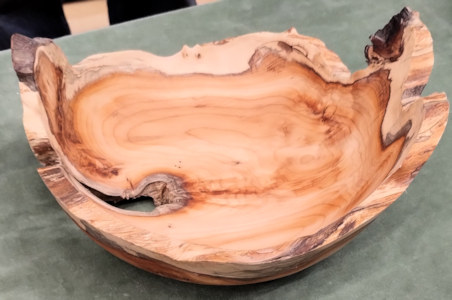
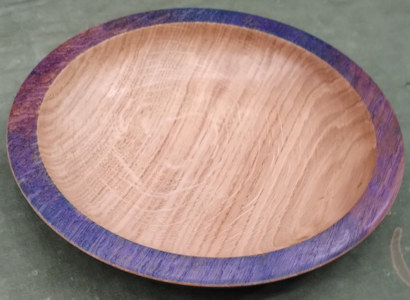
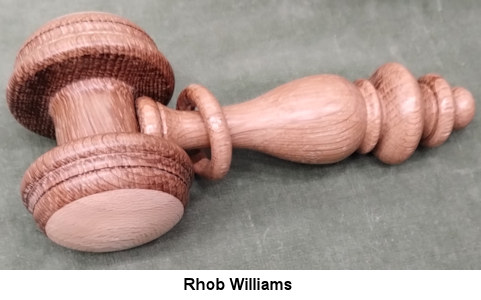
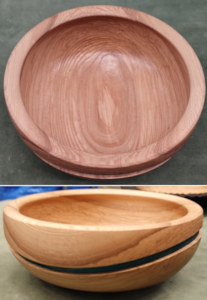
(some of these can be clicked for close up view)
Combination of contrasting woods
with the added feature of captured ring. An intriguing bowl with a wavy
indentation achieved with using his band saw to create a curved cut by feeding
the bowl blank through the blade while on its edge.
Rhob still had some Birch Burr from previous months for a dark curved bowl and
some Charm Jewellery with detailed finishes on all sides.
Finally, some spellbinding adventurous turning of 'cubes within a cube' with
remarkably clean cut corners throughout.
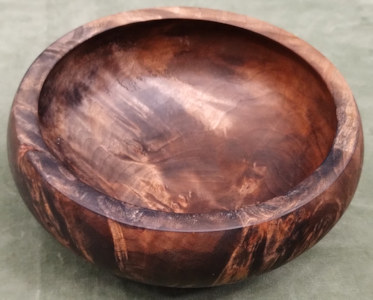
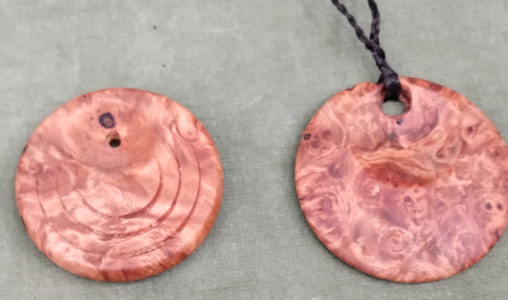
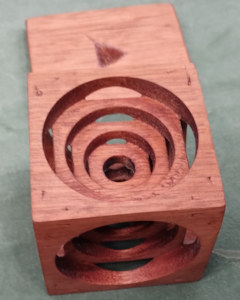
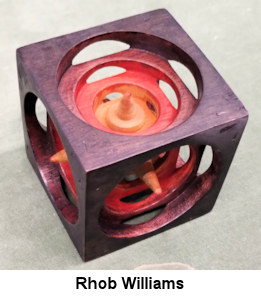
(some of these can be clicked for close up view)
(photos by Dick Bugg)
May 2024 -
Appraisal Table
with Paul Reeves
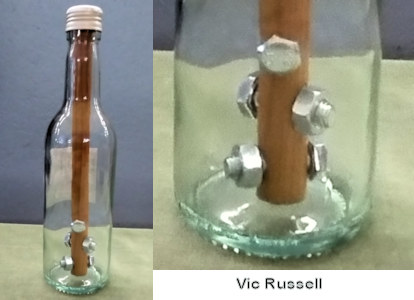
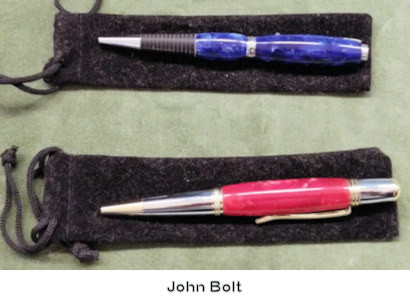
Following on from the
Chairman's challenge along the lines of David Springett's Bottle Trick, Vic's
effort with a long narrow necked bottle was very impressive. John's highly
polished pens were of acrylic & finished with a burnishing cream.
For most Members, the previous month's sunnier weather appears to has kept them
out of their workshops; fortunately Rhob had found time to bring fine samples of
his latest turning. He had several pieces turned from Silver Birch with a
reddish hue heartwood and spectacular burr. The foot of his offset bowl gave
evidence of his method of mounting.
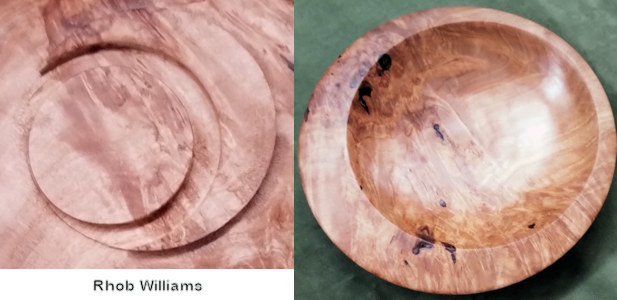
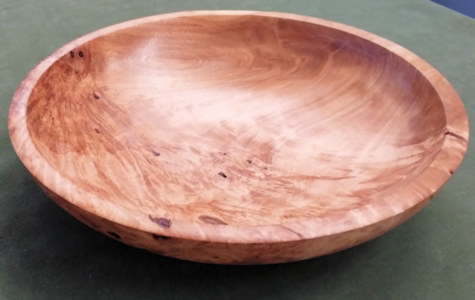
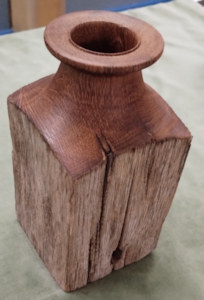
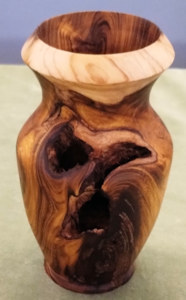
The burr on the low thin bowl
showed off the piece perfectly while his 'gatepost' hollow form brandished its
beauty with its gnarled natural sides and his Laburnum with its holes and
contrasting sapwood.
Rhob's natural edged bowl is of Griselinia Littoralis (a New Zealand
Privet-like evergreen with a difficult to pronounce Maori common name of 'Păpăuma'
and used as a hedging plant). It had lost its inside edge and Paul wondered if
this was by design or just a case of over sanding the inside with a powered
tool.
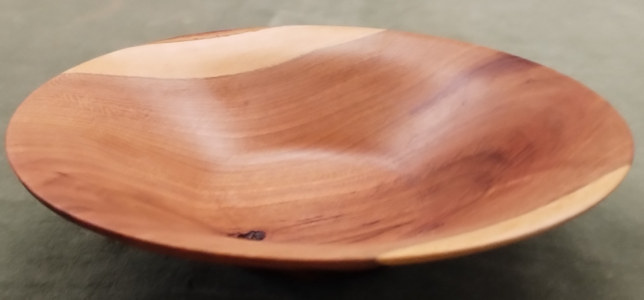
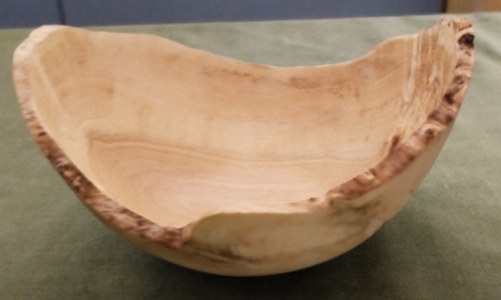
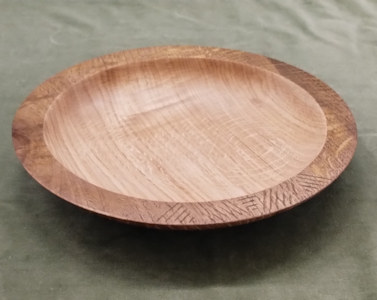
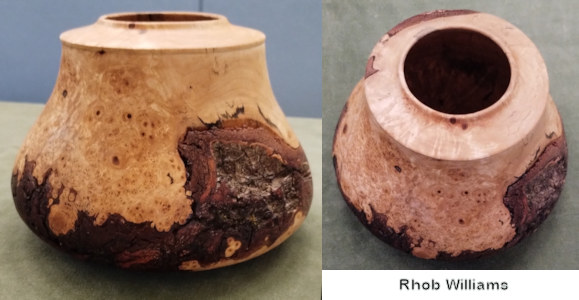
Rhob's figured Oak platter had its rim stained with Colron's 'Jacobean Oak' water stain and abraded back to highlight the indented decoration. His Elephant Foot hollow form was another example of his Silver Birch Burr and was rescued from an original taller piece. Despite this wood being felled more than 2 years before being turned, Paul warned from his previous experience of flat bottomed forms, they had a tendency to bulge with humidity changes. This piece might end up rocking on its base. Paul also commented how pleasing it was to see time and effort taken in underneath decoration to several of Rhob's pieces although that's probably only noticed by other woodturners!
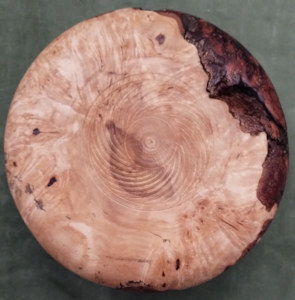
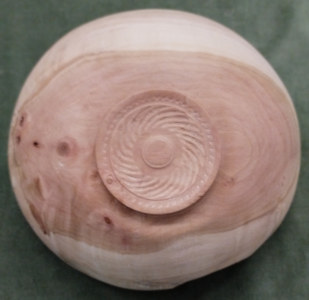
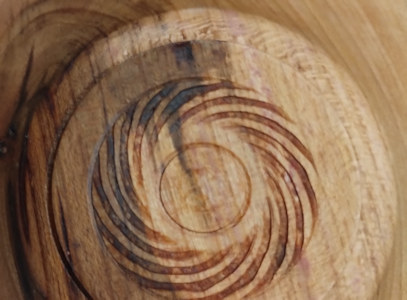
(photos by Dick Bugg)
April 2024 -
Appraisal Table
with Paul Reeves
As is now usual of Rhob, a
varied selection of hollowed pieces had been brought to the table; one with
wings, some off-centre turned and a natural edge - all of which had the time &
effort spent producing good framed decoration underneath. These had also
benefited from a larger angled bevel to his Bowl Gouge compared to his earlier
pieces. Some of them were flat bottomed inside, which Rhob had cut with his Box
Cutter. Paul offered the tip that if one uses a Forstner drill, the diameter at
the bottom will be known precisely so another piece of the same wood turned to
that diameter can be thinly parted off and stuck to the bottom to give an
impressively clean finish. He also commented that it requires considerable
care to sand the sides of a natural edge without removing the crispness of the
tool finish.
Some more of John's (not-so-PC) ladies. Again, the effort of
turning accessories like parasols & water carriers adds to these pieces.
Three more examples of
3-sided bowls. Nick had voiced concern that he would have liked to get his
inner surface a lot smoother than he had managed for his outer surface. Paul's
advice was firstly he had chosen a wood with considerable difference in hardness
between the seasonal growths and that he suspected that he hadn't spent enough
time with his initial abrasive grit to get it as flat as he wanted and that
hoping the following grits would remedy the situation unfortunately doesn't
work. It's more difficult to sand this shape accurately with the lathe turning.
Joe's had even thickness and sharp clean edges while Phil's had turned a
nicely finished (but rather bravely) piece of glued-up wood. The edge thickness
betrayed that a little more of the centre needed removing but going any thinner
would be expecting a lot for the wood glue to do its job.
Andy's adaptation of the seemingly impossible doesn't rely on boiling
water and squeezing sodden wood. He will keep his method secret for a month or
two to see if anyone else can explain the method.
Paul had brought in some past
works explaining some unusual techniques used :-
♦The large hollow form was a cube of Yew turned over 20 years ago, which had far
more cracks within it than he had thought when he bought it from a local
sawmill. These days, Paul admitted that he would likely just chop it up
for the wood burning stove but as a keen turner at the time, he patiently
super-glued dust into all the cracks prior to hollowing out to prevent it
'blowing'. Once completed, he used over 150 copper welding rods, all cut to
length with two holes drilled into the piece in order to make it look more
interesting.
♦The 3-legged stool was a demonstration back in January 2020 which has the
impression of strong and solid but was unexpectedly lighter than it looked by
virtue of shaping the underside of the seat and hollowing out the recess for the
jaws but still leaving a ring of wood with enough depth to prevent the legs from
wobbling.
♦When turning small boxes, Paul likes to not only camouflage their shape but
also to include a surprise inside, eg a tiny turned mushroom or spinning top.
♦The 'Game of Thrones' type hollow form is an interesting project starting with
turning a hollow vase with a wall thickness of 10mm, then turning away sections
of 5mm from the inside to leave the appearance of ribs before carefully skimming
away upright sections of the outer surface to expose those ribs. The result was
sprayed inside with red oxide paint and outside with a Chinese Blue paint
followed by scorching with a blowlamp which had the property of catching alight
the spikes at the top and if left to glow and burn a while before patting them
out, resulted in organic shapes you couldn't create with any woodturning/carving
tools.
♦This Dawn Redwood (Metasequoia glyptostroboides) is the sole living
species of this endangered genus which Paul had turned while still 'wet' and hand
sanded for ages in order to get an even thickness all around the piece. It was
finished with a flat oil, which as Martin Saban-Smith had mentioned was a much
better finish for such a large piece rather than making it shiny & highly polished.
Click <HERE> for Club Years 2023 & 2024
Click <HERE> for Club Years 2021 & 2022
Click <HERE> for Club Years 2019 & 2020